Rebecca Green's Blog, page 5
March 1, 2021
KAFKA AND THE DOLL | PICTURE BOOK PROCESS
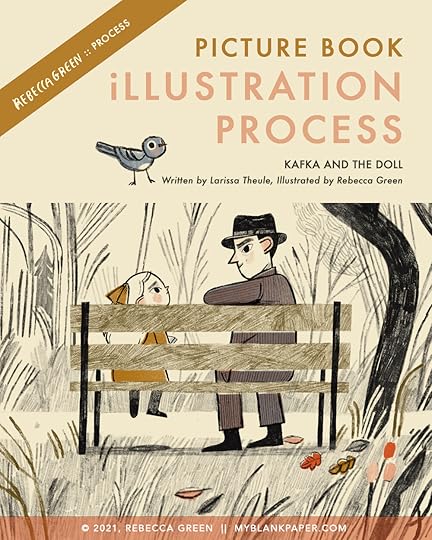
FRIENDS! We made it to March. We made it, we made it, we made it. Anyone else feel like making it through another day, another month, is something worth noting? Just me?
Either way, this is something to celebrate - a book birthday! KAFKA AND THE DOLL comes out March 9th!
KAFKA AND THE DOLL by Larissa Theule
“Inspired by a true story, Kafka and the Doll recounts a remarkable gesture of kindness from one of the world’s most bewildering and iconic writers. In the fall of 1923, Franz Kafka encountered a distraught little girl on a walk in the park. She’d lost her doll and was inconsolable. Kafka told her the doll wasn’t lost, but instead, traveling the world and having grand adventures! And to reassure her, Kafka began delivering letters from the doll to the girl for weeks.
The legend of Kafka and the doll has captivated imaginations for decades as it reveals the playful and compassionate side of a man known for his dark and brooding tales. Kafka and the Doll is a testament to living life to the fullest and to the life-changing power of storytelling.”
My favorite way to celebrate a book is by sharing the illustration process. Not only do I think it’s an interesting insight, but it helps me remember all the decisions I made to get from manuscript to final. For the illustrations in Kafka and the Doll, I feel proud of the simplicity. The process of achieving that simplicity was easy, natural, and took almost no effort. JUST KIDDING. It was agony! This was a tough book for me to illustrate - nearly as impossible as Madame Saqui, which makes sense because I illustrated them at the same time!
Today, I’m sharing a look at the research, style testing, storyboards, and finals. I’ll also end with a note about what I’m learning as I illustrate more books (hint - I’m getting more efficient, so hopefully this is the last of these long agonizing picture book posts!)
OK are you ready? Get your coffee - let’s dig in!
I research most book projects in two areas - subject matter and aesthetic.
Usually I make a pinterest board for every project (find Kafka’s here!) but I also dig through books, documentaries, etc.
The subject matter for this one was of course, Kafka. I also needed photos of Dora and the parks in Berlin, where the story takes place. I researched suits, dresses, and dolls from the time period, and also places where the doll has adventures - Egypt, Barcelona, a den of Peter Rabbit’s, and a Pâtisserie in Paris, just to name a few.

The aesthetic research for a picture book is more subjective. To begin, I explore artwork from the specific place and time. I was in luck here because I’ve long been inspired by German Expressionism. I also make note of contemporary art, colors, line work, textures, and anything that intuitively feels like it might fit in this world. It’s interesting now that the book is finished, to look back at the mood board. I was clearly pulling from the bold black lines, the autumnal color palette, and the aged yellow paper.

STYLE TESTING
I test different styles or looks to see which one captures the essence of the subject matter the best. Sometimes it takes many attempts…
What is style testing? I suppose it’s something I realized I was doing without knowing it.
A couple thoughts on the idea of testing different styles just to clarify my thoughts on them:
These tests are a part of my visualization process - I rarely show these tests to the publisher, they are just for me (and now you!) Style tests aren’t something I learned in school or in the industry so if you don’t do them, that’s totally normal, you don’t have to. Your art director will probably never ask for anything like this!
These are time consuming! That’s a question I get a lot - how do I spend so much time doing these tests when they ultimately don’t get used? Great point! I’m learning that a tight deadline is a blessing and a long deadline is a curse, so I’m finding ways to be more efficient (more on that at the end of the post.)
When I’m exploring character and style, I begin with images I know I’ll need in the final, like Irma sitting on the park bench. It allows me to get a feel for the setting before doing the storyboards. The first tests were pure exploration. I thought Irma might have short hair, I tried a more animation-y style, and I even thought for a second, I’d do the book three-dimensionally. While that last one is a dream I hope to make happen someday, it was impossible for this project.

As I fleshed out ideas, I realized I wanted limited color and heavy line work. I digitally tested out line drawings and did studies in colored pencil. I sent these to the art director and editor and they liked them! But I felt like it needed something.


I felt like the tests were missing warmth and emotion so I used an autumnal color palette and delicate lines. Here (below), I tried colored pencil on oiled paper, neocolor II crayons, and straight colored pencil. I liked the looseness of it all and the warmth but for some reason I wasn’t happy with them. I look at these today, over a year later, and I think they look just fine! I could have stuck with them…
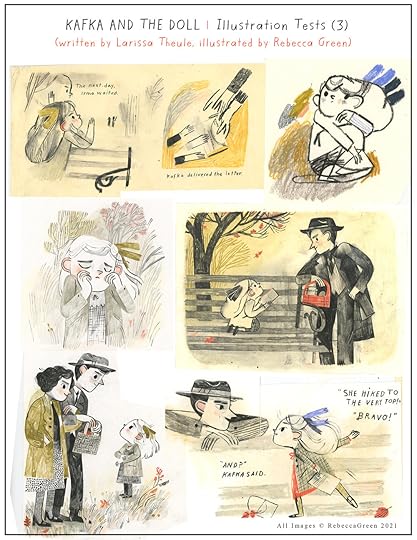

In any case, frustrated for reasons I can’t even remember, 😂 I decided I’d paint the book in a more colorful palette. These were painted in gouache on paper.
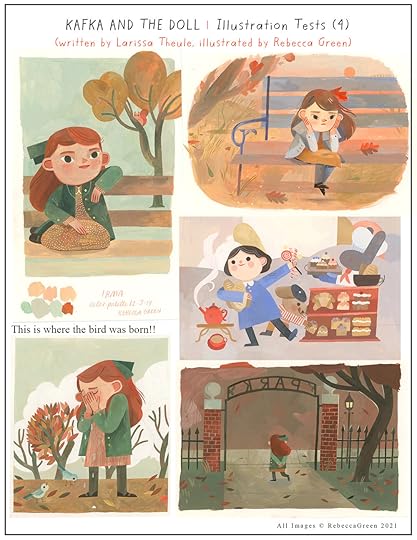
I liked how these turned out but I lost my lines! That dilemma again - it plagues me. How to have the juiciness of the paint, but keep the expressiveness of the lines. I’m still trying to figure it out.
I went back to the drawing board AGAIN. Early in the testing, I had drawn something extremely loose, hung it on my studio wall and kept coming back to it. (It’s the loose drawing at the upper left) It was so full of life! I decided to jump back in with the line work and follow that. That’s when the final Irma was born! I tested her out in colored pencil but ultimately decided to do the finals digitally so I could add in the textured colors under the line work.
 STORYBOARDS
STORYBOARDSThe storyboard, oh the storyboard, my sweet nemesis.
Doing the storyboard is my least favorite part! I haven’t been able to nail down a single storyboard process in all the books I’ve worked on. I’ll make tiny booklets with thumbnails, print the manuscript and cut out all the text and try and tape it into a paper booklet, or I’ll do part of it digitally with bits and pieces on scrap papers. It’s a mess! But listen…I just figured out how to make the process ridiculously simple - I’ll share with you at the end of the post!
For Kafka and the Doll, I did a couple tighter versions of the sketches for the storyboard before finding my groove with looser studies. Below are some of the pages I sent to the publisher. I drew on 4x6” ish paper with oil pastel and colored pencil. The drawings were scanned, put together in photoshop, and sent as a PDF.
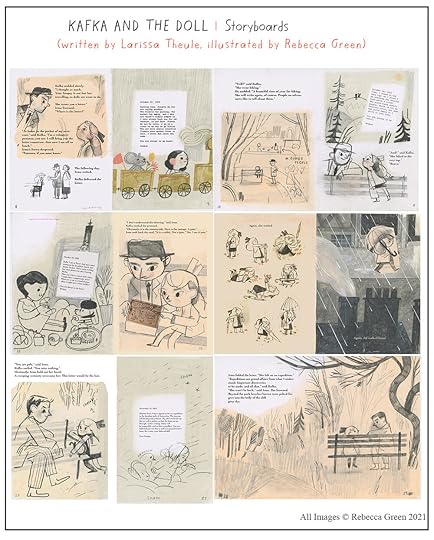 FINALS
FINALSThe finals were all done in Procreate! Here are a couple of my favorites and a little time lapse video of the doll putting mail in the mailbox.



 AND JUST FOR FUN…
AND JUST FOR FUN…Here are some sketches of the cover along with the final!


And there you have it! I haven’t seen the actual book in person yet but I’m looking forward to it. It never gets old, holding the freshly printed book in my hands.
If you’d like to pre-order the book, you can find it here! Huge thanks to Tamar, Nancy, Opal, Larissa, and the rest of the team at Viking Press. It was a huge honor, as always, to bring this book to life.
As promised, I also want to share a couple things I’ve been learning as I work on more and more picture books.
Every picture book is different.
The publishers, editors, art directors, authors, and books themselves can warrant different approaches. In the beginning, this was confusing because I felt I needed to learn a ‘secret code’ to the picture book process. Now I’ve come to appreciate that each book has its own unique process. Now I revel in the changing process, knowing that I can learn, adapt, and become more efficient with every book I illustrate.
Visual storyboarding is much easier if the text is paginated in words first.
Sometimes the publisher will provide a paginated manuscript where they’ve already laid out the text for each page. It’s more common for me now to get a block of text and decide with the publisher how many pages it should be. I then break up the text - keeping pace and suspense in mind. For the longest time, I tried to paginate the text in drawings, doing the visual layouts before I really knew how the story would be paced. Now (and this is the genius idea you’re probably already doing) I plan the entire pagination process in words. I don’t even start drawing ideas until I’ve broken down the entire manuscript into a paginated form. I also write down the illustration notes, and then once that plan is approved by the editor, I draw the storyboard. I don’t know why it took me almost 8 years to figure that out!
Okay friends! That was a long read - if you’re still with me, thank you! I hope it’s helpful to see these process posts, if only to understand that there are many ways to illustrate a book. If you found this helpful and want more behind the scenes, you can check out Madame Saqui, Revolutionary Rope Dancer, Iqbal and His Ingenious Idea, and Becoming A Good Creature.
Lots more to share in the upcoming months, but for now, Happy March! Happy almost Spring. Enjoy the warm sun on your shoulders or the breeze in your hair when you need it the most.
xo,
Becca
February 1, 2021
An Intermission from Instagram

Hi Friends.
Two notes for you before we dive in.
The first is that I’m thankful for you. I value community and having this space to share, and an audience to share it with, means an incredible amount.
Second, is that while we’re talking about Instagram today - I understand how silly it is to take a month’s post to talk about an app. If you’re an artist on IG though, I hope this post resonates if you sometimes (or often) feel frustrated with the whole thing. I’m also not making judgements on how others use IG for their work. Whether you have a flip phone and have sworn off sns for life, or you’re a Grade-A, Capital-I Influencer, know that today I’m just sharing my personal experience.

INSTAGRAM | The joys of connection, the tidal wave of doubt, and a much needed intermission.
I rarely discuss Instagram, which is strange because it’s my main marketing tool. There’s a good chance if you’re reading this, Instagram is where you found my work. If not, great - there’s life outside of social media yet! I quit fb/twitter long ago and don’t miss them, but Instagram is a powerful tool for artists. Since joining the platform almost a decade ago, IG has had a near daily impact on my reality, work, connections, business, and self worth. The landscape of the platform has changed - incrementally, it’s gotten busier and demanded more from creators. I try to keep up with the changes so I can take advantage of them, but I also resent the creeping pressure to become a multi-media videographer/content creator/personality. When I’m painting, aka doing my job, I sense I should be running a parallel business of capturing it and sharing it. Who can paint like that? I sound so old, and if I do that’s ok, I think I am actually 117 at heart. Anyway, me and IG are not jiving right now and haven’t been for a while. This post and this break have been a long time coming.
Let’s dig in then shall we? It’s a long one so grab your coffee or tea, put some warm socks on, and settle in.

The Joys of Connection
Let’s begin with gratitude at the forefront.
I could speak at length about the reasons I love IG. I acknowledge how relevant it’s been for my career. I don’t for a second take that for granted. Sharing my work and process on IG has allowed me incredible opportunities that wouldn’t have happened without it. I’ve connected with artists all over the world - and some of those friendships have spilled into real life. My husband and I have moved 5 times in the last 10 years and each time, I’ve been able to connect with artists in new cities - as well as keep in touch with those I miss when I move away. When I have a gallery show, a drawing event, need a studio, or have a book coming out - IG is the community I turn to. We share, connect, learn, and collaborate. It’s a gold mine for meaningful interaction and sharing art.
Besides sharing my own work, of course, there’s the gift of seeing others’ lives, perspectives, and worlds. Especially in 2020, the platform blossomed even more into a place for activism, social justice, and change. It spurred a wider conversation around racial equity, climate change, and more. It’s also kept many of us connected through a global pandemic, where anxiety and isolation are felt deeply across the globe. And creatively, it’s wildly inspiring to witness people ALL over the world making beautiful and relevant things, whether it’s performance or painting or cooking. It’s amazing really.

The Tidal Wave of Doubt
While I can’t articulate scientifically how social media impacts our psychological well being, I’m interested in learning more about it after witnessing how it affects my own state of mind. I watched The Social Dilemma recently and have also been reading accounts of others who’ve ditched social media or found alternate ways to thrive. Two books on my reading list are DEEP WORK (been on my list forever) and DIGITAL MINIMALISM, both by Cal Newport. He also has a thoughtful blog & podcast I’m leaning into. I especially love this post about Analog Social Media - something I think a lot about after living abroad and this pandemic. My perspective has shifted from career growth to….making enough of an income to live, making art I love, investing in community, going to the theatre, volunteering, joining clubs, and being around humans! When we replace real world interactions with only digital versions, we lose something. Furthermore, it’s unsettling when those on the other side of the screen know only a skewed version of us (which is always the case unless they’re our closest of friends). This leads me to the personal and artistic complications of presenting ourselves on a platform like IG.
When I started posting a decade ago, I personally didn’t feel pressure to share or edit certain things. I didn’t attempt to build a brand around my work. I shared my life, friends, food, art, traveling - the usual. As time went on the follower count grew, which was amazing, but it brought a lot of ‘shoulds’ to the table. Posting started to feel heavier, the stakes higher. The need-to-be-liked people-pleaser part of me buddied up with my self-defeating perfectionist tendencies and together they snuggled in tight with the imposter syndrome I felt about having those followers at all. I loved myself, but waaaay deep down, I had a lot of hangups about my worth. It’s been a long process of accepting myself and I couldn’t have explained any of this until recently - and still everyday it takes work. It’s taken years of reflection, months of therapy, hours of Queer Eye, meditation, and journaling to realize how much I can love myself, and allow others to love me too - however well they know me, or however I present myself. In the most basic terms, we have to accept and celebrate ourselves in order to withstand the enveloping and unpredictable tide of social media. Whether we show up as alternate versions of ourselves or allow complete strangers’ experiences to affect our realities, we’ll never find true belonging on a platform like that if we don’t feel like we belong in our own real lives.
Artistically too, there’s a double edged sword in seeing productivity and inspiration from those we follow and admire. It’s incredible to see innovative work, to root for our peer’s accomplishments, and to see others thriving. But if I’m not feeling confident in my work or myself (or if I’m obsessively turning to IG for companionship) a tidal wave of doubt clears the ground from under me. I lose sight about what I actually want to make and can feel inferior when others post amazing work. Or, I can judge my work on the feedback/numbers it receives instead of critically thinking about how I’m progressing. As a commercial artist, I already have to stake claims to my time and focus in order to grow and have a fruitful practice. Being bombarded by other’s work and success can diminish that already fragile connection I have to my own artistic voice. There’s also the very real cost of distraction. Making art takes mental focus and time. It’s one of the hardest parts of the job…actually sitting down and creating.

A Much Needed Intermission
Taking a hiatus from social media is scary but scarier still is that recalibration, for me, isn’t possible without it.
Like so many, I’ve come to rely on Instagram as a parallel reality. Besides seeing what others are up to (artist and friends) I share my life, work, process, upcoming books, events, etc. My fears about stepping away include being forgotten, but also the sense that I should be grateful - I should be taking advantage of that dedicated space and audience online. The last couple of weeks I’ve been popping on to see what arose for me. Mostly, I felt like garbage, scrolling through the endless noise. But there were bright moments too - seeing posts of friends, getting kind DM’s, and the like. I’m a bit more aware of what I want when I jump back in. I’ve decided not to plan a concrete time schedule. Could be three months, could be six, could be a year. The last thing I need is for my break to be another project. In doing that, I’d focus instead on what I was learning while away so I could jump back in with an epiphany. Coming back to the world after a break, a vacation, or a burnout rarely feels like lightning. Instead it resembles little slivers of light, spark by spark coming out of the clouds. I have no reason to feel that this will be different.
So what’s next? Will I be back? Of course. Will I be completely strict in staying away? Mostly, but I’ll still be making sure trolls don’t roost themselves by doing a little sweep every now and then. I also have a book coming out next month so I’ll be back to share that for a bit. But for the most part, I’m eager to step away and see what blossoms in my life. I’ve slowly backed off the last couple of weeks and already feel a shift..
I read more instead of reaching to be lulled (or stressed) by scrolling
I realized I need meaningful input, so I found some blogs I love (like this one). I also recently subscribed to Harper’s Magazine, which I’ve always felt was too sophisticated for me. Someday I’ll be old and wise enough to be a subscriber, I thought. I turned 35 over the weekend and realized I’m an adult so I bought myself a subscription for my birthday!
I’m looking at my work differently. My task as an artist is not to compile bite sized pieces of progress to blitz into the world, hoping to gain attention for a couple of hours. My work, like most other artists’ work, is deeper and steadier. What I share on IG can be a companion or glimpse of that, but it is not a replacement.
The biggest thing I’m excited about is that I’m not taking a break from work or life, but quite the opposite. I’m focusing more on those things by letting go of the pressure of social media. I’m thrilled about what’s next in my career. I’m eager to put more energy into this blog and my newsletter. I’m concentrating on writing my own books, taking control of the direction of my work, digging into 3D and design, illustrating and painting without sharing it immediately, possibly building a little membership platform to dig even deeper into process, and reopening my online shop this year. I also have personal changes coming up in my life and am keen to be present in those shifts. Regarding marketing (something I have much to learn about), being off IG is a bit exhilarating - a good challenge of finding old school ways to stay relevant. I can reach out to podcasts, send work to companies/publishers I’d like to work with, or find new and lucrative ways to collaborate with others on meaningful projects. Maybe even pin up some drawings to brighten the bulletin boards of my local grocery store. How analog can I get?
In researching for this post and break, I did find some inspiring stories and resources - perhaps if you’re feeling like you need some time away from social media, you can find solace here too:
Let Go to Grow: On a Blogger’s Decision to Trade Social Media for a Quieter Life by Cal Newport & Mika Perry
Quit Social Media. Your Career May Depend On It by Cal Newport, from NYTimes
Especially loved this quote: “A dedication to cultivating your social media brand is a fundamentally passive approach to professional advancement. It diverts your time and attention away from producing work that matters and toward convincing the world that you matter.”
What I Learned From Quitting Instagram for 6 Months from The Healthy Maven
Sick of Nothing Working on Social Media? Try These 3 Surprising Strategies - Episode 304
I almost didn’t listen to that last episode of Creative Pep Talk Podcast bc I was worried it’d lure me back into IG! But Andy does a great job of outlining the uses for different forms of social media - and the first strategy really resonated with me
One Year After I Quit Social Media by Julia Bausenhardt
I truly value the community I have on Instagram. I’m going to miss seeing updates and work, and let’s be honest….other people’s pets, but I am looking forward to life unfolding in a new way, eyes away from my phone so much. I’m looking forward to digging into work and am happy, maybe more now than ever, to able to share meaningful content with you every month here on the blog and in my monthly bulletin.
Here, on the first of every month, I share insights on illustrating and life as a freelance artist. You can find posts on the picture book process, or balancing art and business. Sometimes I share exercises to get out of your comfort zone, or zeroing in on your creative compass. If you’d like a little extra, I send out a companion newsletter to the post each month in the form of my Illustration Bulletin. I share news on upcoming events, features, interviews, book releases, etc. Also, I link to little treasures that have nothing to do with art (spoiler, they’re mostly recipes I’ve tried and loved!) If you have specific things you’d like to see in upcoming posts/newsletters, feel free to leave them in the comments here. Also, March is going to be a packed bulletin. I have a new illustrated book coming out by Larissa Theule called Kafka and The Doll from Viking Press. I’ll be sharing a deep dive into the process of the illustrations PLUS a little gift to my subscribers to celebrate one whole year of the Illustration Bulletin ❤️You can sign up on the bottom of my site!
WOW Ok if you’re still reading this, thank you, it was a long one I know. But really, if you’re confused about loving and hating social media, I get it. I hope this post helps remind us all that it’s not the be-all end-all. Maybe every once in a while, we need a break to reclaim our time and our minds, to know that there’s a whole big world, and a tiny detailed one too, going on all around us. We don’t need a screen or thousands of followers to be seen, heard, understood, or celebrated.
A big high five to you friends. Happy February.
xo,
Becca
January 1, 2021
Happy New Year + A Little Ten Year Celebration!

Hi Friends! Happy 2021!!
How are you? Taking things one day a time? Finding joy in the tiniest of places? I’ll be honest - I almost pushed today’s post to next week. I thought, “…it’s a Holiday, I should be eating pie in my pajamas and watching Steel Magnolias for the 127th time…surely no one will miss me.” But like many of you, I’m home this season, I’m working (though I am taking breaks) and I felt like maybe someone out there might feel comfort in reading this on New Year’s Day. So if that’s you, we can collectively ring in this new year together! ⚡️HOORAY for 2021!
A Little Ten Year CelebrationFor January’s post, if it’s not too indulgent, I’d like to celebrate ten years as a freelance illustrator.
I began my career (and this blog!) in 2010 after graduating with a degree in illustration. At first, I took every job I could get. If there was art to be made (and a little money to be made from it) I was game. I never had a business plan. In many ways, I let others’ expectations and commissions carry me from one project to the next. Along the way, however, I’ve watched and listened and trusted and failed and learned.
In many ways, the last decade has felt like a century. My husband and I have lived in Grand Rapids, Phoenix, Denver, Nashville, and now Osaka. I’ve done fine art, markets, retail, animation, picture books, portrait commissions, workshops, editorial work and once was even hired to design an ice sculpture. I don’t share this to showcase accomplishments but to show how haphazard a seemingly steam-lined creative career can be. Because I moved through like these events at breakneck speed, I didn’t stop to acknowledge the joys or the lessons I was learning.
Recently though, I’ve slowed down to reflect on my values and the insights I’ve learned. The isolation of 2020 has been a catalyst, but there’s also immense solitude in working from home in a foreign country. I’ve never experienced such a deep loneliness (which is perhaps a post for another month…) but I’ve come to appreciate this time alone to reflect. It’s helped me organize my thoughts around creativity so that A. I can share them with you and B. Make the next ten years joyful, sustainable, and rewarding.
Let’s get to the good stuff then, shall we? Today I’m sharing, in no particular order, the three most important things I’ve come to value in my life and work. They are not exhaustive and each section could be its own book, but for the sake of simplicity, and so we can actually get on with our new year, I’m keeping it simple!
Here we go!

1. CHANGE
Change is constant in life of course, but it took me a while to accept this in my work. I always assumed I would ‘arrive’ and things would be settled and great. Once I ‘found my style’ I’d be good. Once I got ‘that book deal’ I’d be set. My work has changed immensely in ten years, but each change was a stressful plateau and transition. I fought and questioned each pivot. Now, thank goodness, I know I’m not moving towards a pinnacle, rather, I’m evolving endlessly and should strive to continue evolving. One project, one style, one process will never define me, though it might define a moment in time. Allowing myself to grow instead of thinking I should be a way I was before allows me to truly thrive.
HOW DO YOU SEE CHANGE IN YOUR OWN CREATIVITY?
Appreciate growth by looking back over the years and seeing changes you’ve made. Sometimes these shifts will be subtle, other times, they’ll be major pivots. Either way, acknowledging transitions affirms that we’ll be ok on the other side of our next shift.
Change, or the need for change, is different for everyone. Even though my career has shifted down a thousand tiny roads, your pace or direction of growth might look more subtle. And that’s great - as long as you change for and with yourself, when it suits you.

2 (A). CONNECTION (COMMUNITY)
Connection to OTHERS (community) is easy to take for granted until you do not have it. School can be a haven for creatives to connect, though I never thought about how lonely an illustration career would be until I graduated and moved away from my community. Moving endlessly has compounded the pursuit. It’s highlighted though, not only the necessity of belonging, but also the responsibility I have to facilitate connections. I cannot create in a vacuum - I need others to bounce off of, to commiserate with, and to get encouragement from. Social media is great and I love my Instagram community - but truly, I owe everything to the couple of friends who hold me up when I’m falling apart. It’s important to connect with those who really see me.
WHAT DOES YOUR CREATIVE COMMUNITY LOOK LIKE?
If you are yearning for community, try to wrangle 2-3 people in your creative circle. Try to set up a monthly (or weekly) creative chat to give feedback, support one other, or talk through ideas. Virtual is less fun than rl but it does allow us to meet from anywhere in the world.
Say Hello First. (This can be scary!!) It took me a long time to finally feel confident enough to assert myself and meet strangers as an adult. But chances are, others are waiting (like I was) to be said Hello to. Know that you are worth meeting, and don’t feel discouraged if it takes some time to burrow into a creative community.

2 (B). SELF REFLECTION
Connection to SELF. This one is HUGE. When I am creatively frustrated, it’s because I am disconnected from myself. For instance, maybe: I’m producing way too much and my non art self needs to cook, or dance, or stare at trees or go to garage sales. I am an artist but I’m also a complex human with non art needs. I need to explore other things to keep my artistic self balanced. Being frustrated can also look like: I have tried every attempt at mastering this project and it still doesn’t feel like ME. Oh I wish I could make art like this person, or this person. In reality, I’m literally trying to make work like other people and it’s a weird and uncomfortable disconnect. There is a razor thin balance of taking in inspiration yet letting ourselves shine through. For me, connecting to myself happens outside of the studio in forms of meditation, journaling, or physical activity.
DO YOU MAKE TIME FOR SELF REFLECTION?
Meditation - If you feel like you can’t meditate ‘right’, me too! I avoided it for so long because I felt I wasn’t good at it. This year though, I’ve meditated almost everyday. I put on a guided meditation, grab my headphones, and settle in. I’m especially fond of the meditations from The Mindful Movement. When I need to get into the right headspace for a project, I like this one! Somedays yes, I sit in quiet and pay attention to my breath, but I’ve found that I’m much more likely to do it if I’m guided by someone else.
Journaling - I had journaled visually for a long time and hope to pick it up again. This year though, I’ve been writing every morning without imagery. I started doing morning pages from The Artist’s Way, but settled on one page per morning instead of three. It’s been monumental in revealing patterns of frustration, gratitude, or self doubt. Some days I have epiphanies - other days I write grocery or to-do lists, but the main thing is that I am connecting to myself.
Physical Activity - I didn’t really exercise growing up. I felt like it was a pain, a struggle, something I had to get good at or see immediate results from. Now, I move for physical/mental health, and self connection. Because I stand or sit all day to work, I need that burst of movement to keep me balanced. I don’t do anything fancy - I just use the guided videos from Fitness Blender (I LOVE them!) or I do Yoga with Adriene. Both are free!

3. EASE
Ease is counterintuitive when you feel the pressure to excel and elevate your craft. I’m sure you’ve heard the principle that creativity happens when you ‘let go.’ Ideas come to us when we’re doing the dishes, taking a shower, or falling asleep. Ease can be more subtle though. To cut tension in my process, I might put a ‘ground’ down on my paper so it’s not a scary white sheet. Or, I acknowledge that I can’t capture every style/process I love into one piece of art. I limit my materials and/or colors. I expect that the artwork in front of me won’t be the last. These are all ways of creating ‘with’ and not ‘against’ myself.
WAYS TO INCORPORATE EASE
If you’re scared to begin drawing, trying drawing on an envelope or a scrap of paper. You can try PLAY exercises too, to loosen up and ease your way into making.
Look at past projects you’ve made. If you’re like me, you struggled through them and perhaps put a little too much pressure on them. Understanding that you can always start anew allows you to put less pressure on each individual project. Then, you might find that the process is easier, maybe even fun.
How have the last ten years shaped you? What are three things you’ve learned that will help you thrive in the next chapter? In celebrating our achievements (the big ones, but especially the small ones!) we come to understand our creative selves better. Through that, we might even be able to get out of our way and enjoy the process a little. So it’s a cheers to the past, and cheers to the future too.
Thanks for celebrating a piece of your New Years with me. I’m thrilled, like all of you I’m sure, to be winding down 2020. Things won’t magically shift once the clock strikes twelve but somehow being on the other side of midnight feels hopeful, even if it’s a small glimmer. I’m thrilled for a fresh year, and am so grateful for those who make this world a better place. And for you - thank YOU for being here.
Cheers Friends and a Toast to a Happy New Year!
xo,
Becca
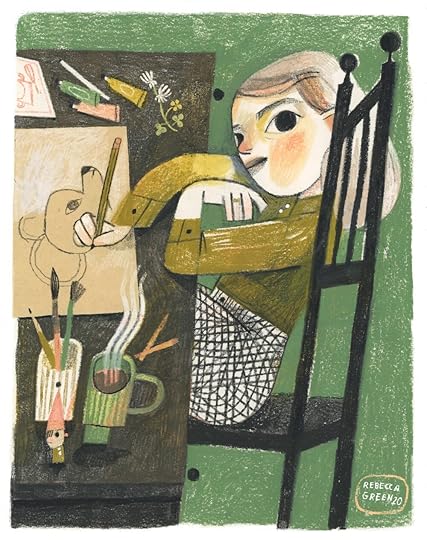
PS - it’s me, I’m not gone yet!
I wanted to share a little self portrait I did recently. It was so satisfying, and fun, and I’m thinking I’ll do this every year. I wish I had the last ten years of self portraits. No time like the present to start though right?
Also if this is your first time reading my blog, you’re probably like, this girl is SO full of herself, she made us celebrate her ten year freelance anniversary AND look at her self portrait! What a vain lady!
I promise that’s not the norm!
December 1, 2020
PLAY! | Deliberate exploration & merriment

Happiest of Decembers Friends.
This month, we’re discussing PLAY! (How jovial!)
It might seem to some, that as artists we spend our days blissed out, bowing to the whims of the muse, lost in childlike wonder of free play. You don’t have to make art for a living though, to know that the creative process is not what it was when we were children. As adults, it’s common to feel uncertainty when we create.
My mind often swirls with thoughts, “Am I doing this right? What does this work say about me? I thought this was supposed to be fun…” And when it is fun, I think, “Shouldn’t I be working!?”
“The creation of something new is not accomplished by the intellect, but by the play instinct arising from inner necessity. The creative mind plays with the object it loves.” – Carl Jung
Play is essential in life, in relationships, and especially in our work. It generates ideas and insight, our inner knowing, if you will. Play fosters enjoyment IN the process instead of guarding it until the end. The result rarely matters. To me, playing is one of the most important components of a sustainable artistic practice.
It’s unfortunate then, that play was weirdly absent from my artistic education. I went to school for Illustration and Graphic Design - something seemingly brimming with the potential for play. The assignments were mostly rigid though. There was a result needed at the end, and a clear example of what that result should be. It was only on my own that I began to understand the need for fun, for exploration, for the ability to fail freely.
There are many types of PLAY (Sixteen, if you want to get scientific about it) but today we’re focusing on CREATIVE PLAY. In creative play, one “…can produce/change an idea or product in a way that is different and artistic by using their imagination and materials they find around them.” (Sourced HERE.)
Today I’m sharing a couple exercises that I do when I’m feeling a bit stuck. You don’t need much, in fact, the less you have, the better!
Get your proverbial cardboard box, and let’s dive in!
This is a workshop I recently taught with SCBWI in Tokyo, and it was SO fun!
It’s a lighthearted no-expectation sort of project where anything goes. Better yet, it strengthens and expands our visual vocabulary without any heavy lifting.
YOU’LL NEED:
Paper (scraps, lined, newsprint, construction paper, an old bag - anything goes)
Scissors, glue, colored pencils, markers, glitter, any materials will work!
See below for a couple ideas - these were the materials I used

First, make medium to large random shapes on your paper. This can be done in paint, marker, cut paper, anything. Next, add smaller texture or detail lines. The more aimless the better.


Now it’s time to build an image with the shapes you have. Rotate your paper. What do you see? Rotate it again, now what do the shapes remind you of?
I’ll show you four examples of the images I saw when I rotated my paper.
NOTE: I drew these out only to show you my thought process - I don’t actually draw these out in real life, I just make mental notes of the lines.
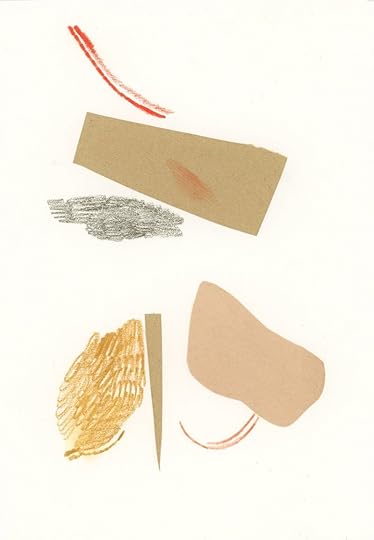







That last one, you can see I looked at the negative space to find the shapes! The hardest part about this whole process is that I wanted to do them all. In the beginning, I had no idea what I wanted to draw and suddenly, I had four or more potential pieces. I decided to go the leaf raker!
Below is a step by step of the process. At first, I had the idea of the two large top shapes being the arms. Once I started the drawing though, they looked like ears - so I made it a rabbit! Then, of course, I had to deal with the impossibly short torso. And where would the arms go?! What resulted was a playful representation of a character - born of necessity and limitation. That’s what I mean by an ‘expanded visual vocabulary’.
View fullsize
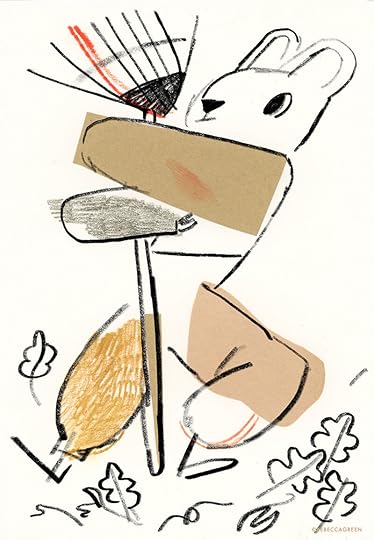
View fullsize

View fullsize

View fullsize

View fullsize

View fullsize

View fullsize

View fullsize

View fullsize

View fullsize

View fullsize

View fullsize

I think this can be such an easy project to throw into your normal routine - maybe you set aside an hour or two a week to play on a new image. Maybe you keep a jar of scrap papers on your desk to use for when you’re frozen in front of a blank piece of paper. The end result might not be something that goes in your polished portfolio, but remember, the result here is not important. Failing is better than settling sometimes.
PS - If you’re interested in learning more about the SCBWI event with the Japan Chapter, Naomi Kojima did such a thoughtful write up on the event. You can read the full post here.
PROJECT 2: THREE DIMENSIONAL PLAYThis is often my play activity of choice. Working in 3D is freeing since I’m usually painting/drawing.
I don’t have an academic run down of this process, but I’ll share what I made.
Basically, you take an object - any object - and repurpose it into something new. You’re a sculptor today, but don’t worry about having fancy clay or the nicest tools. You already have everything you need in your house, I guarantee it.
YOU’LL NEED:
An object or two - cardboard, bottle caps, plants, a belt, an old sock - literally anything!
You’ll prob want glue, tape, or string - nothing fancy!
Paint/markers/etc - painting your creation really helps tie the whole thing together
To begin, I picked up a branch of berries on my walk. I had no idea what I was going to do with them.
I grabbed and envelope and some water soluble crayons too.
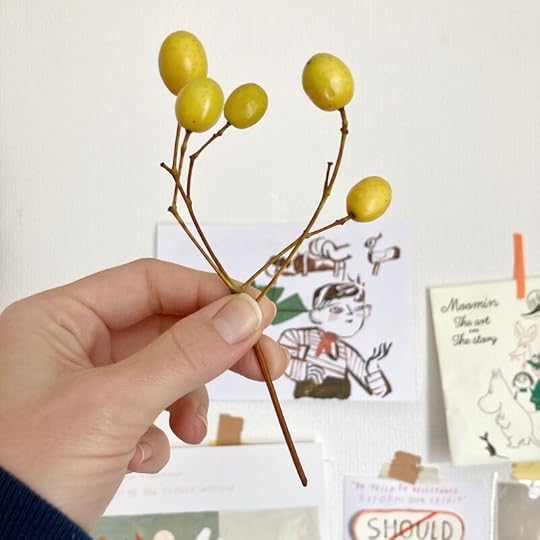

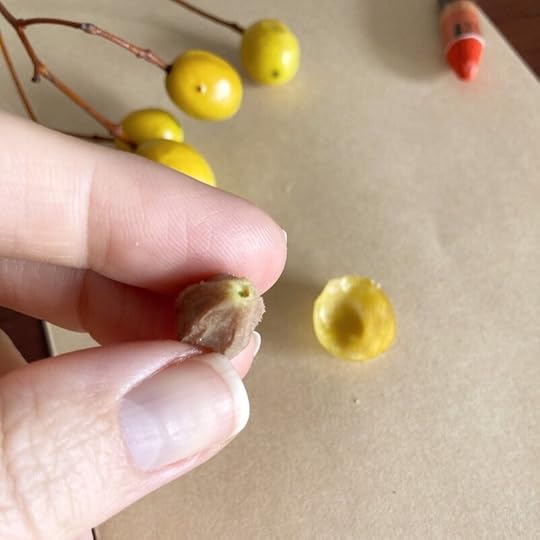

I don’t know what these berries are but I cut one open (they smelled weird!) and clean off the pit. I rolled it around in some paint - which felt very elementary. I started to doubt my professionalism! I wasn’t sure what the berry skin could be..maybe a balloon? Maybe a moon?
The group of remaining berries looked like eggs and with the stems piled up, I decided to do a birds nest. (I never said I was the most creative!)
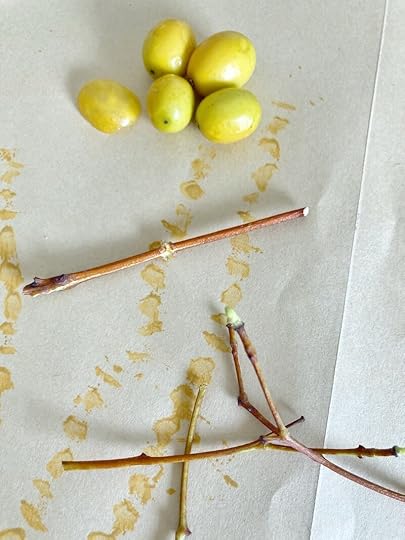



When I realized I needed a bird, I ran to peel the leaves off a dead plant on my balcony. That’s when I personally know I’m ‘in the flow’ when I just intuitively grab objects to add. I start with limited materials but add things if I need to. I’ve never made a bird out of dead leaves so I just started gluing them together. Wonderfully for me, one of the leaves looked the head of a cockatoo!
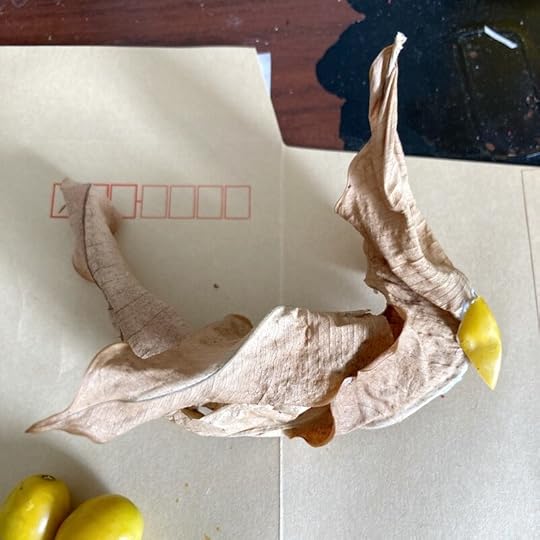

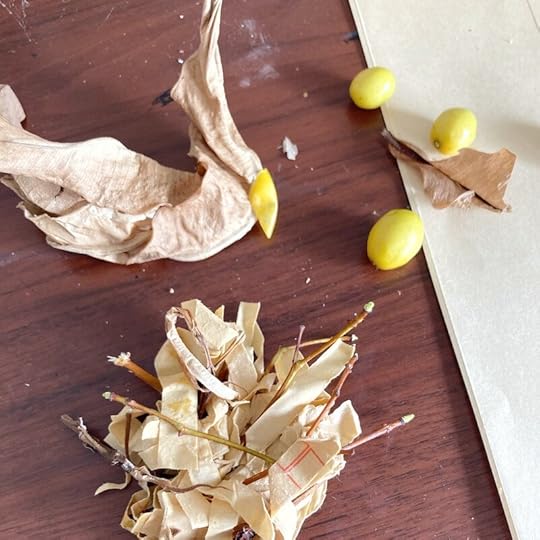

I cut my berry skin into a beak and glued it on. Then I shredded the envelope for a nest. I added gluey water to the whole nest and poked some of the branches in so it’d all stick together. I cut another berry skin for an egg so I could add a baby bird, because I love to have interaction between characters. (See how this works? I started with berries I picked off the ground, and now there’s a story of a bird and her sweet hatching baby!)
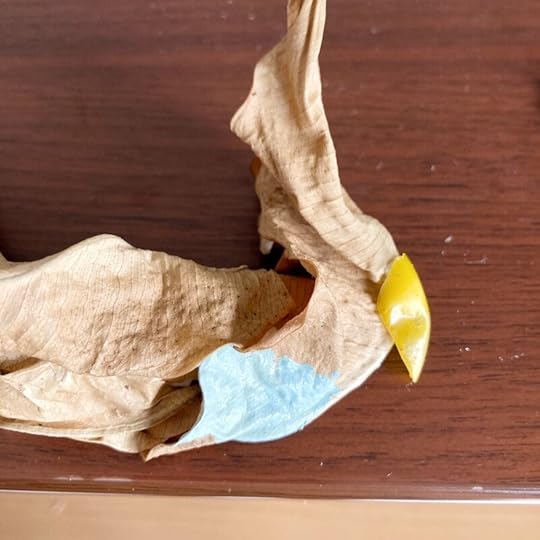



Next, I painted my birds with acrylic gouache. I also painted two additional berries. Then, I grabbed more of the dead plant to act as a branch and I placed it on a bigger manilla envelope. I painted wisps of clouds and a coral sun to give the background a hint of atmosphere. I took one pic with the baby bird and one final one with just the adult bird.

Aren’t they sweet?!
For the final photo, I decided just to have the adult bird on the nest - and I even gave her some legs (as well as a darker beak!) I took all these pics with my phone and edited them in snapseed (Which I use to edit all my pics for IG) so nothing fancy.

Ta-Da! An hour or two well spent. It’s nothing elaborate or profound. It’s not on its way to Sotheby’s and it won’t win me any awards. But damn it felt nice to make things without pressure. To feel like a child, fervently invested in turning some berries into a piece of art.
I learned to keep pushing, to problem solve, to seek, and to make due with limited materials. And everytime I work like this, it strengthens my understanding of my own impulses - that’s huge!
The funniest part of all of this is of course justifying play as work. EVEN THOUGH IT IS! I kept imagining someone walking into my studio and me shooing them away, “I’m working! Don’t interrupt me!” I’d say, while gluing dead leaves and smashed berries together. “I’m on a deadline!”
In all seriousness, PLAY is for everyone no matter your age, profession, background, etc. If you want a couple more insights into the science of play, I found a couple of interesting talks/articles in my research:
How To Add More Play to Your Grown Up Life, Even Now in the NYT
Play is More Than Just Fun with Stuart Brown
The Power of Play from Jill Vialet
If you have more, or books on the subject that you find interesting, feel free to share them in the comments!
I skimmed the surface here but play in creativity is so layered and intriguing.
I hope this new month brings joy your way. It’s been a long, wild year with changes so vast and long-lasting, some of them overdue and incredible - some of them painful and tiresome.
Perhaps you can find time this month and in the coming year to seek out play in all its forms - from dancing to wrestling, imagining, baking, writing, singing, whatever it is that makes you come alive.
If you do make sculptures or ‘found’ images based on today’s projects, share them with me! I want to see them. You can use the hashtag #rebeccagreentutorial - I check that to see what all of you are up to!
All my very best to you as we wind down 2020.
My plans are to dig into work (I have a new picture book I’m working on that will be announced next week!) and to busy myself with cooking and baking. For Christmas, my husband and I have a tradition of making cinnamon rolls the morning of - this year we’ll be making these black sesame cinnamon rolls again (we’re obsessed!) Also planning to make chilis, lots of biscuits, steamed Japanese sweet potatoes AND I really want to nail down my ramen game and make some noodles from scratch. You can follow along on Instagram - Maybe I’ll be better this month at sharing more of my life, projects, and behind the scenes. Anyone else feel such a love hate relationship with IG? NOW I’M RAMBLING and that’s a whoooole other conversation.
Ok friends, Happy December!
Take care of yourselves and each other.
October 31, 2020
Into the Unknown & Autumn in Japan
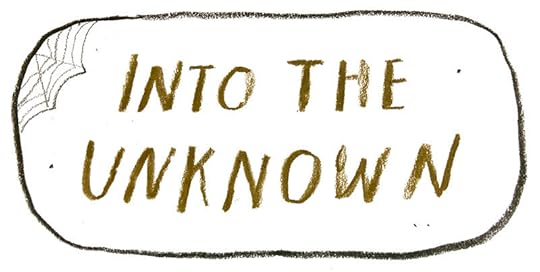
Happy Halloween Friends!
Whether today finds you hunkered down at home, dressing up with little ones, or simply reading a scary book in crisp weather, I do hope you’re well. This is a weird and wild year so I know I’m not alone in feeling like it’s hard to fully celebrate. Still - it’s lovely to be able to share some thoughts with you today, on this, my favorite holiday.
Today we’re talking about creative transitions. It’s fitting in two ways: transitions are spooky and terrifying and I always feel a great shift from Oct 31 to Nov 1.
In my ten years of illustrating, I’ve pivoted often. From different industries, to different agents, to different art materials. It’s always scary! Not only is it tough to let go of something you’ve invested time and energy in, it’s overwhelming to tread into unknown waters. I’m currently shifting my work - stepping away from illustrating picture books, to writing, sculpting, and retail - with a touch of teaching too! (I’ll still be doing picture books but not in the same capacity.) It’s been a long and confusing transition and I thought I’d share three things that helped me navigate it.

Light a candle for the old, light one for the new too.
It’s best to celebrate and honor what you’re leaving behind, just as much as it is to celebrate the smallest milestones of your new venture. Leaving something you’ve worked hard for doesn’t mean you can’t appreciate it, look back with pride and gratitude for how far you’ve come. Similarly, when you begin something new, it can be difficult to see progress in the beginning. It’s key to celebrate the small accomplishments as they happen. Maybe you found an hour to write for a book idea. Perhaps you cooked something from scratch the first time. Allowing joy to happen in the process helps us keep going for the long haul.

Carve the details, even in the fog.
Have you ever had an inkling of something you’d like to try but it seems foggy in the details? Maybe you want to launch into another industry but you can’t quite explain what that will look like. When I began thinking about a shift in career, I’d get defensive if anyone asked me to nail down what I meant my ‘changing my work.’ I didn’t how how to talk about it, because it was more of a feeling than a plan. That made me distrust my instinct which was confusing. To get over that, I began to carve out what projects might look like in my ideal future. I wrote, brainstormed, and made mood boards. I also made a compass jar! I reach out to collaborate with others and put things into motion. Once I starting to lay out plans, they almost revealed themselves. Learn to trust your instinct enough that you lay action plans to your foggy dreams.

Letting go is a loss, but it is also a gain.
Clinging to something we’ve put energy into is not always easy, but it can be easier than letting go. It’s quite hard if you build your identity around a specific type of work or industry only to feel the need to walk away. It feels like starting over from scratch. But it’s interesting what happens when you say no and make room in your life for the things you really want. When you have time to say YES to the things you love, it’s an incredible feeling. And regarding the loss of identity, the sooner we can detach our worth from our career identity and productivity, the better.
We’re constantly changing and pivoting, that does not end. But what might get easier is learning to accept and celebrate moments. Learning to be clear with our intentions, and letting go, making room for all the good stuff. I hope in this year of transition, you find your way.
I wish you all the best last day of October, wherever and however you’re celebrating.
And now…onto a painting!
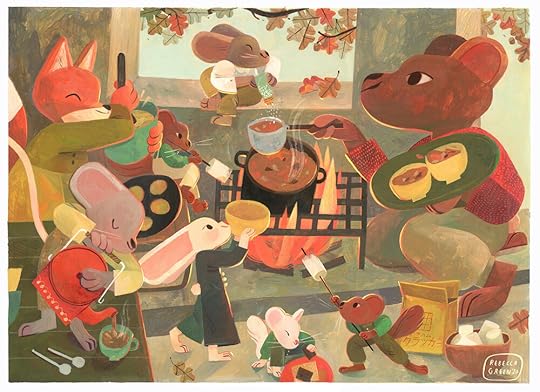
Autumn in Japan is magic. I do not say this lightly, as a lover of Autumn. I grew up in Michigan and basically lived for the brief stunning couple of weeks that is Fall. The season here is different but just as sweet. Apples are not doted upon exclusively, but chestnuts and sweet potatoes take the crown. Oaks and Maples in the US (that I’m used to) are breathtaking, but I’ve never seen an Autumn leaf as striking as the Japanese Maple when it turns fiery red. The weather is more mild where I am in Osaka so the sunny Autumn days seem to last before the brutal cold sets in.
This painting is an ode to Autumn in Japan. An ode to friendship and fire and cooking outside in good company. I had originally planned to share three Fall paintings with you, but alas, my projects piled up and I spent all my energy (and then some) on this painting. It’s called Hirakata Feast. Shall we dig in?
The painting is based on a day spent with two good friends, Chihiro and Tetsuko, cooking around a fire in Hirakata City. We made fire roasted sweet potatoes, kabocha croquettes, vegetable Japanese curry, s’mores, and pizza from scratch! (Needless to say there was lots of food to take home.)
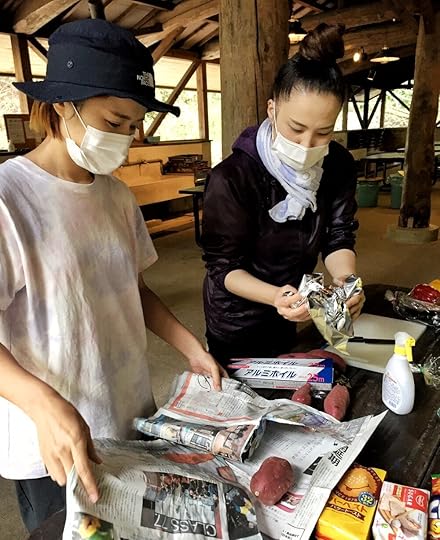

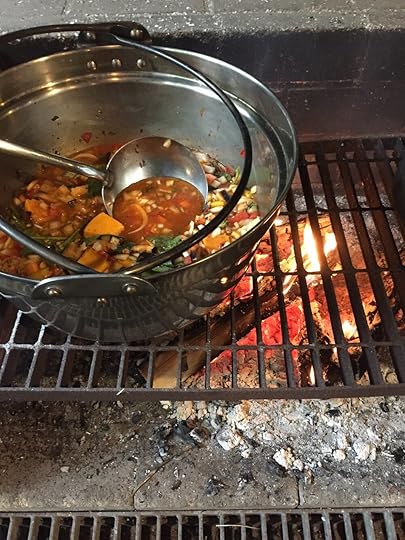
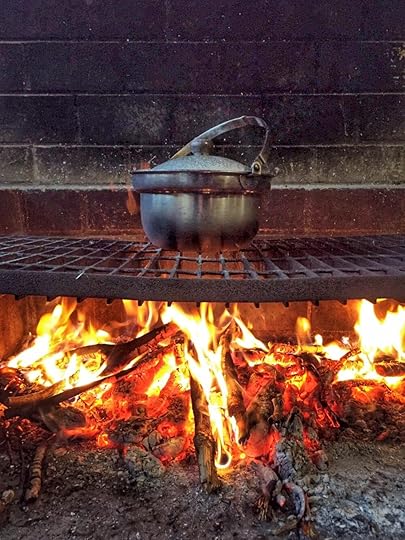
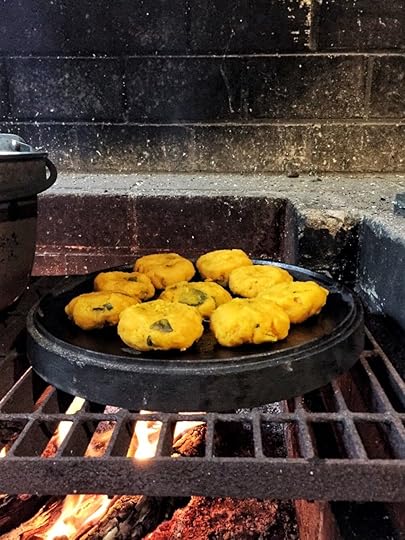



There’s nothing better than making food outdoors over a fire with people you love and it was much needed after everything that is 2020. I got back to my studio filled with inspiration and started the drawing at once.
NOW before I begin, I’ll be wildly honest with you. I don’t love the painting. I might redo it entirely..or do another version of it. I can’t tell you how many times I gave up on it and tried to start over. What kept me at it was telling you I would share it, and knowing how much gain there is in finishing something. This is less of a tutorial and more of a behind the scenes look at the indecisiveness that is painting!
TO BEGIN.
I did the drawing in a warm toned colored pencil on Strathmore 400 Series Smooth Bristol Paper.

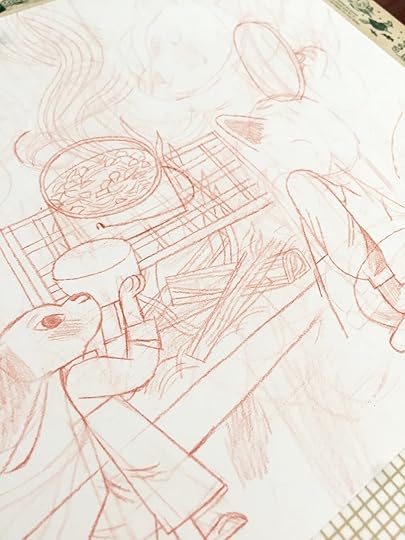
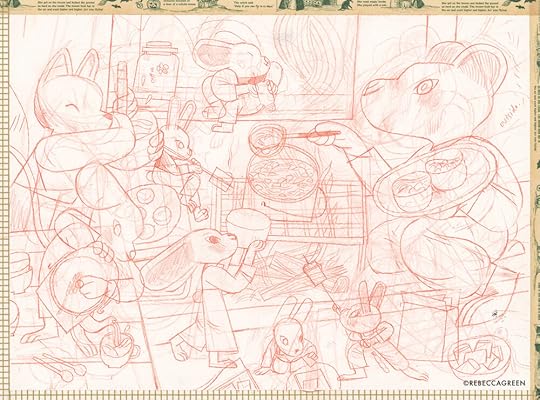
As you can see, I worked the entire piece out on paper before moving onto paint. The washi tape on the edges is nothing fancy, I just ran out of painters tape. (It is Halloween themed though so that’s fitting!)
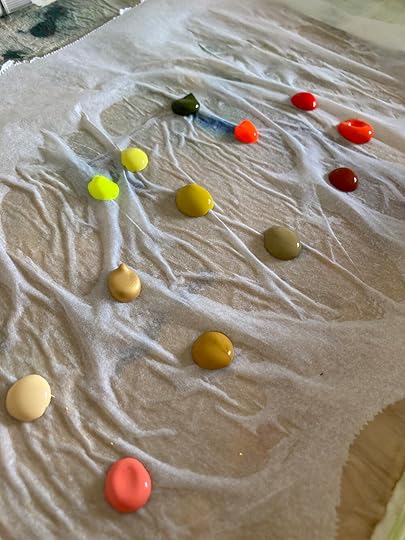
I prepped my palette, laying down wet paper towel in a lidded masterson’s sta-wet palette. I usually put tracing paper over top of the paper towel but all I have right now is parchment paper which works fine. This is acrylic gouache, so it does not re-wet, it needs to have a damp palette.
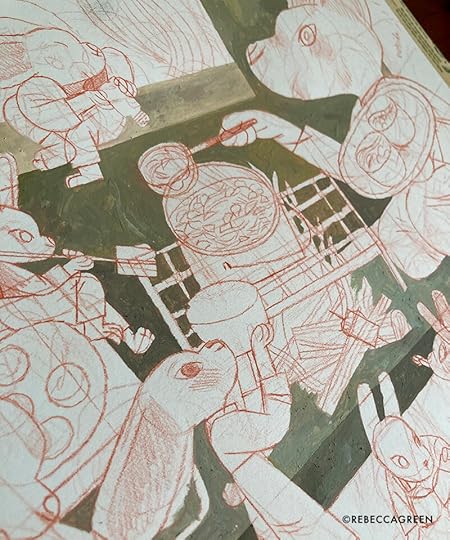
I usually start with the background or largest area. The quicker I can cover the white of the paper, the better, as it helps to balance the values.
After I got the background in, I started to add some darker areas..
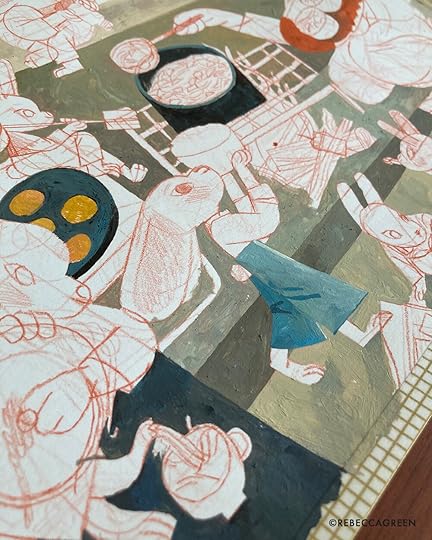
At this point, I thought blue might play a role, but as I got deeper into the painting, I realized I had too many colors to keep track of…

Right about here is where I felt like my colors started to get away from me. In hindsight, (or if I redo this painting, which I honestly might) I think I’ll choose three colors and make those work. Trying to balance a spectrum of colors within the same environment or lighting can be hard. Obviously doable, but having too many colors can make me feel like I have to be too true to life.
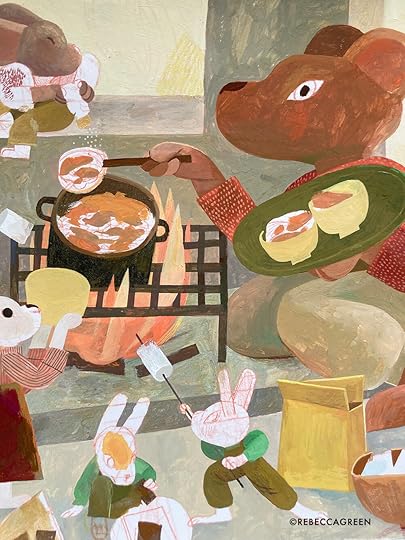
I decided to go the green route! I felt like maybe I needed burgundy to balance it out. You can see in the rabbit’s pants, my layers of indecision.

I love to have transparent textures. One thing that can happen though is if you paint over something too many times, you obviously lose that texture as you can no longer see the white of the paper. To solve this, I simply paint over the area with white, let it dry, and begin again, as you can see on the fox.
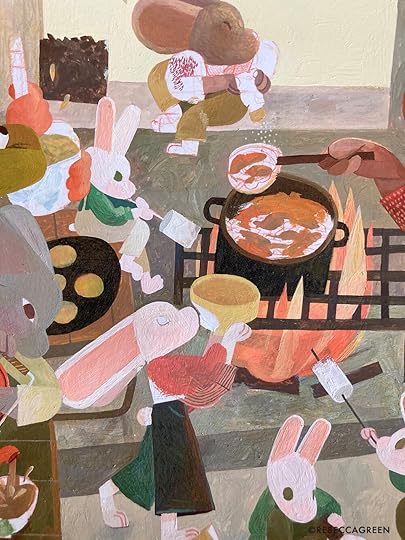
Here, you can see I’m trying to figure out the rabbit’s clothes. I also had the three s’more making cuties as rabbits but decided it wasn’t balanced well. Instead I decided to round their ears out…more like martens! This is where my patience dried up. I wanted to give up - there were so many moving parts, it was hard to tell what was even happening!
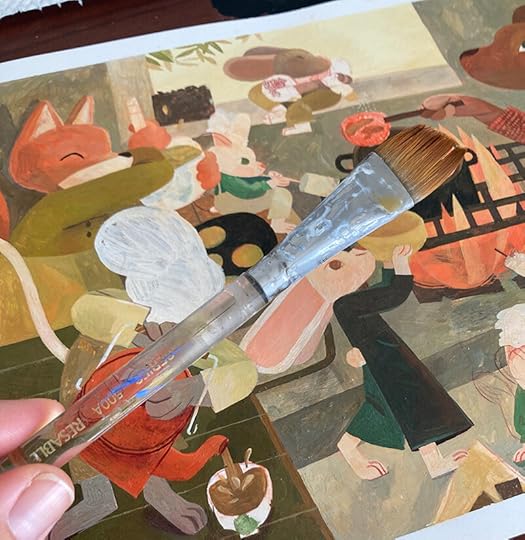
I covered the areas I was unsure of with white AGAIN. I also took a large brush and painted a super thin layer of watery ochre over the whole thing - just trying to bring it all together. At this point…well let’s just say I never want my paintings to get to this point. It’s like adding so much sh*t to chili that you don’t know how to balance it anymore. It’s too bitter or salty or spicy and the more you add, the more you throw it off. Painting is a lot like cooking, overworking something ruins it…
ANYWAY I was like, there might be one person out there who wants to see this thing finished, even if it’s not me. So I scanned it and finished it in procreate. Did I cheat? I’m not sure. Did I finish it? YES.
Here she is, FINISHED!
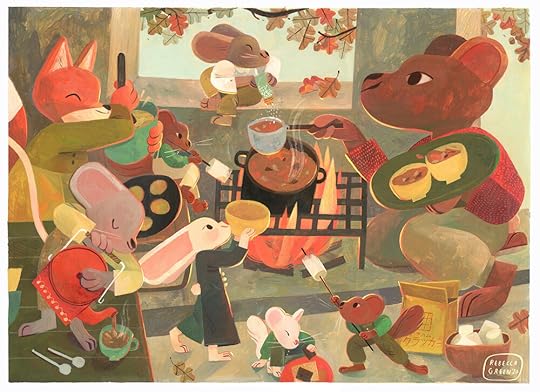

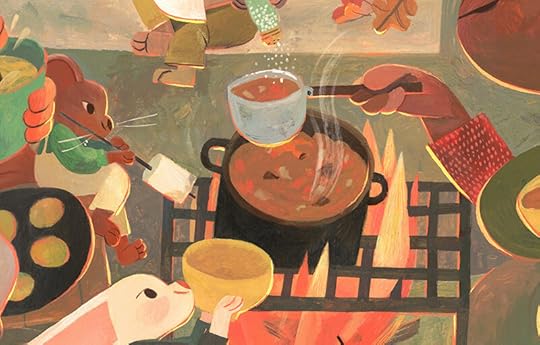
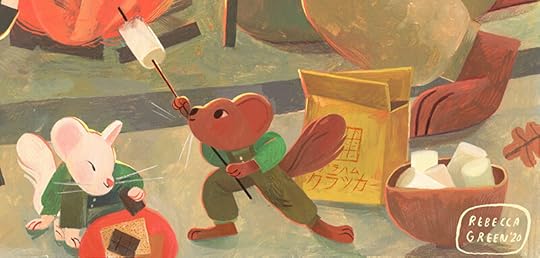
Here are some details of the final! I don’t hate it - I’m not sure I love it, but I probably need to not look at it for some time. I’m proud I finished it, and learned a ton about planning color and balance. I call that a win. All in all, what I’m most pleased about is spending time with friends around a fire. Painting aside, that was the true gem - the experience itself.
I hope you all are finding ways to celebrate, ways to show up, and ways to learn. Cheers to Autumn, to transitions, to finishing what you’ve started and launching into new unknowns.
Happy Halloween friends. Happy November, Happy Autumn (or Spring depending!) and Happy Painting.
xo,
Becca
October 1, 2020
Becoming A Good Creature: Picture Book Process!

Friends, it’s October!
Not only does this mean apple crisp on heavy rotation, it also means we’re celebrating a book birthday!
BECOMING A GOOD CREATURE by Sy Montgomery just landed in bookstores and on bookshelves! What better way to celebrate than to take a peek at the illustration process. We’ll meet some of the lovely animals, dive into the preliminary sketches, and see some of the final interiors. As many of you know, I worked on Sy’s best-selling adult memoir, HOW TO BE A GOOD CREATURE. When our editor Kate shared the news of a picture book version, I was over the moon.

As many of you also know, I’m a glutton for punishment when it comes to process. I’m usually a stress ball when I’m illustrating picture books. There are always tears. There is always frustration. I overthink and change course and confuse much of the process. Need Proof? Becoming A Good Creature was different though - it all seemed to fall into place without too much of a fight. After a couple of studies, I found my groove, settled into a color palette and had the whole book sketched out like nobody’s business. I’ll take it!
OK let’s jump in! But first a little more about the book from the publisher. They can describe it much more eloquently than I can.
“School is not the only place to find a teacher. In this picture book adaptation of Sy Montgomery and Rebecca Green’s New York Times best-selling How to Be a Good Creature, learn the many surprising lessons animals have to teach us about friendship, compassion, and how to be a better creature in the world.
Sy Montgomery has had many teachers in her life: some with two legs, others with four, or even eight! Some have had fur, feathers, or hooves. But they’ve all had one thing in common: a lesson to share.
The animals Sy has met on her many world travels have taught her how to seek understanding in the most surprising ways, from being patient to finding forgiveness and respecting others. Gorillas, dogs, octopuses, tigers, and more all have shown Sy that there are no limits to the empathy and joy we can find in each other if only we take the time to connect.”
- Excerpt from Houghton Mifflin Harcourt

Sy Montgomery
Sy Montgomery, naturalist and author, has written over 20 books. The New York Times has called her “Equal parts poet and scientist.” That’s a wonderful description. I would, though, like to add another equal part ‘friend.’ She’s instantly likeable, extremely warm and just lovely to be around. I was lucky enough to meet her in 2018 to host a book event for How To Be A Good Creature at Parnassus in Nashville. After the event, we visited the zoo, where Sy inquired who everyone was. I don’t frequent zoos much but when I do, I think it’s normal to say, ‘What is that? What’s that in the cage?’ Did you see what that was in the tank?’ But Sy never once swayed from saying, ‘Who is that? Oh I wonder who that is…who do we have here…” What a treat to meet animals with her and to see her unwavering compassion and connection to creatures of all kinds. I feel very lucky to know her and to have been asked to bring her story to life.
The Sketches
If you’ve read How To Be A Good Creature, you’ll be pleased to find some familiar faces in Becoming A Good Creature. There’s Molly, Sy’s childhood scottish terrier, the emus in the Outback, the small but ferocious winter weasel, and of course, Christopher Hogwood! I illustrated new ‘teachers’ as well, from tigers in India to lions in Africa. The opening spread has a plethora of potential teachers! Since it’s my favorite spread of the book - let’s start there.
I’m not going to lie, this spread took forever to lay out! But it was worth it in the end. After some quick doodles on paper, I did all of the sketches digitally in Procreate.


©2020RebeccaGreen

Here’s the finished sketch. A fun little fact: I added the meerkats not only because they’re some of the most heart melting creatures on the planet, but also because Sy and I met some when we had our lovely zoo visit!
Onto more sketches! My goal for the book was for it to feel created by Sy herself - hand written notes, books, photos, journal pages, etc. interspersed with illustrations of her and the animals.

©2020RebeccaGreen

©2020RebeccaGreen

©2020RebeccaGreen
Below is the storyboard. The most beneficial aspect of seeing all the pages like this is to make sure I have an even amount of layouts - spots, single pages, spreads, borders, and full bleeds. Doing this digitally is SO MUCH easier than doing it by hand. which I did not that long ago.

©2020RebeccaGreen
The Finals
Once the sketches were approved by the team at HMH and Sy, I went to work on the finals.

I first tried colored pencil but it didn’t have the punch I wanted. I switched to gouache and that was the ticket! I could make big bold marks and have lots of lush colors.

©2020RebeccaGreen
The illustrations were created in acrylic gouache, but I did edit some of the pages digitally in Procreate. The opening spread is a good example. I loved how the piece turned out but I was struggling to figure out the best way to incorporate the water (underwater and above - it’s tricky!) I edited that area digitally, adding in the otter and the turtle. While I love to paint, having digital tools has helped my process so much.
Here’s a before and after.

©2020RebeccaGreen
Above is the raw file - no editing. You see two tones because those are overlapping scans. Because I don’t have a giant fancy scanner, I have to scan all of my larger illustrations in pieces and combine them in Photoshop. Once I have all of the segments combined, I go through and heighten the levels as needed and clean off any dust/dirt/etc. I then take it into Procreate to edit if needed. This isn’t ideal but I don’t mind since I’m not a digital artist and it works for me. I always create a separate layer for edits in Procreate and I bring them back into my PSD file in Photoshop for finishing. I love Procreate but the quality for finished work is not always on point. I can lose quality or color, so imo it’s best to polish everything off back in Photoshop. Adobe or Procreate be damned, I’m not taking sides, I’m just loyal to the work and whatever it takes to get me there. I’m ruthless!

©2020RebeccaGreen
Above is a finished close up of the opening spread. I know I’ll get a lot of questions about which brushes I’m using here to match the gouache texture, but it’s nothing fancy. I use the turpentine default brush that comes with Procreate and a couple other dry media brushes.
Here are some of my other favorite illustrations from the book. Most of these had minimal digital edits, thank goodness.

©2020RebeccaGreen
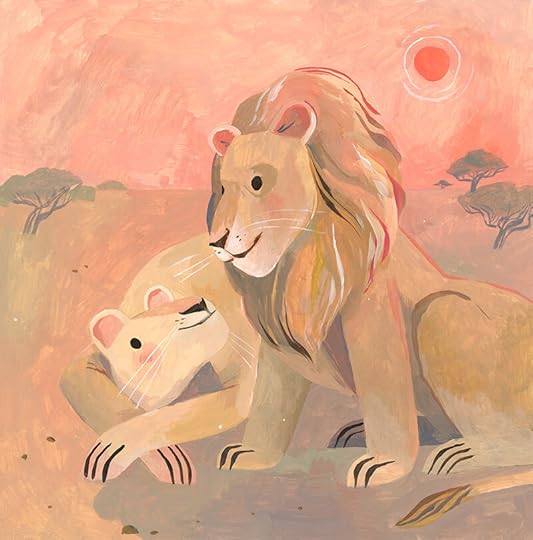
©2020RebeccaGreen

©2020RebeccaGreen
Once the illustrations were finished, I worked with the designer, Jessica, who did a wonderful job laying out the book for print. I did some of the writing by hand and she chose a lovely font for most the text. They even did a beautiful silver foil on the cover! Below is some of the hand lettered text I wrote out in black colored pencil.

Words ©2020SyMontgomery
Once the book was designed, I recieved color proofs from the printer. For a couple of the pages, it was tricky to get just the right colors printed. With covid, it was a bit difficult for me to send the printers the actual artwork, but we worked around that and they did a great job. They were patient with my many color requests!
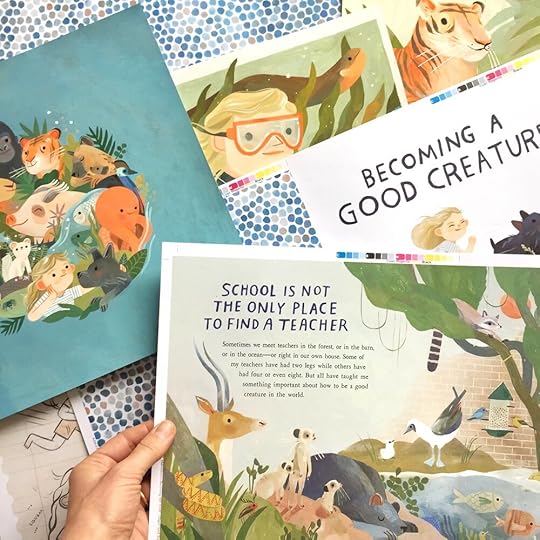
After the color proofs are approved, the hard part is over! After that, it’s just a matter of patiently waiting to get the actual book in your hand. And what a good feeling that is.

Once the book arrives, there’s nothing else to nitpick over. Just the satisfying feeling of giving something your all and hoping it makes its way into the hands of many readers.
If you’d like to get your copy, the best place is to order it from your local bookstore. Otherwise, you can buy it from the publisher here! You can find the replay of the Virtual Book Launch here at Porter Square Books (and order from them - I know they have signed copies!)
Also, HMH put together an awesome free activity kit for the book, and I recently created a coloring page!
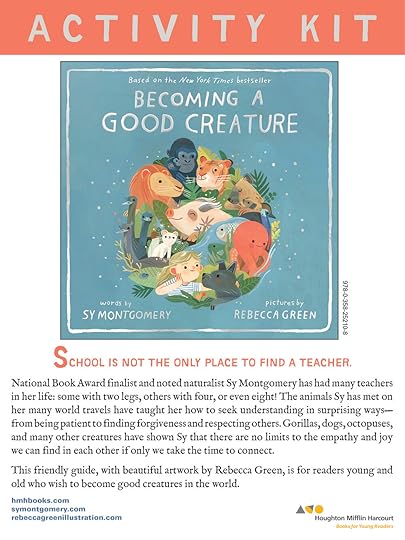
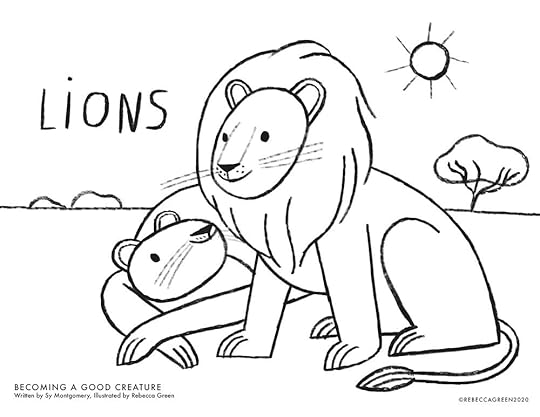
Huge congrats to Sy and the team at HMH for a beautiful and much needed book. May we all learn and continue to grow, to be the very best creatures we can be.

ALSO
It’s October and I can’t go the whole month without posting SOMETHING about Fall or Halloween so this month there will be two blog posts. I’m excited to share a new series I’m working on. It’s a simple Autumn series - one for September, a spooky October painting, and one for November..before the first snow. If all goes well, fingers crossed, I’ll share the first painting mid October.
The weather is getting colder here, I feel more like myself, and with mostly all client work out of the way, I’m on to writing my own books FINALLY and I’m diving back into doing personal paintings again. If you’ve been following my work a while, you know I like to pivot. In coming months, I’m transitioning my work - taking back the reins, pushing it in new directions, allowing my voice to be stronger, and putting my own vision into the world. I’ve got plans for books, retail, sculpture…maybe a patreon? I’ve been saying that for months now, maybe I’m nervous and I just need to jump on the train. In any regard, I’m looking forward to what’s next…
And I appreciate YOU for being here with me on this journey of figuring it all out.
Happy October friends.
May the caramel and pumpkins and cinnamon and apples swallow you up and leave you feeling cozy, warm, and hopeful.
xo,
Becca
Becoming A Good Creature: Picture Book Process!

Friends, it’s October!
Not only does this mean apple crisp on heavy rotation, it also means we’re celebrating a book birthday!
BECOMING A GOOD CREATURE by Sy Montgomery just landed in bookstores and on bookshelves! What better way to celebrate than to take a peek at the illustration process. We’ll meet some of the lovely animals, dive into the preliminary sketches, and see some of the final interiors. As many of you know, I worked on Sy’s best-selling adult memoir, HOW TO BE A GOOD CREATURE. When our editor Kate shared the news of a picture book version, I was over the moon.

As many of you also know, I’m a glutton for punishment when it comes to process. I’m usually a stress ball when I’m illustrating picture books. There are always tears. There is always frustration. I overthink and change course and confuse much of the process. Need Proof? Becoming A Good Creature was different though - it all seemed to fall into place without too much of a fight. After a couple of studies, I found my groove, settled into a color palette and had the whole book sketched out like nobody’s business. I’ll take it!
OK let’s jump in! But first a little more about the book from the publisher. They can describe it much more eloquently than I can.
“School is not the only place to find a teacher. In this picture book adaptation of Sy Montgomery and Rebecca Green’s New York Times best-selling How to Be a Good Creature, learn the many surprising lessons animals have to teach us about friendship, compassion, and how to be a better creature in the world.
Sy Montgomery has had many teachers in her life: some with two legs, others with four, or even eight! Some have had fur, feathers, or hooves. But they’ve all had one thing in common: a lesson to share.
The animals Sy has met on her many world travels have taught her how to seek understanding in the most surprising ways, from being patient to finding forgiveness and respecting others. Gorillas, dogs, octopuses, tigers, and more all have shown Sy that there are no limits to the empathy and joy we can find in each other if only we take the time to connect.”
- Excerpt from Houghton Mifflin Harcourt

Sy Montgomery
Sy Montgomery, naturalist and author, has written over 20 books. The New York Times has called her “Equal parts poet and scientist.” That’s a wonderful description. I would, though, like to add another equal part ‘friend.’ She’s instantly likeable, extremely warm and just lovely to be around. I was lucky enough to meet her in 2018 to host a book event for How To Be A Good Creature at Parnassus in Nashville. After the event, we visited the zoo, where Sy inquired who everyone was. I don’t frequent zoos much but when I do, I think it’s normal to say, ‘What is that? What’s that in the cage?’ Did you see what that was in the tank?’ But Sy never once swayed from saying, ‘Who is that? Oh I wonder who that is…who do we have here…” What a treat to meet animals with her and to see her unwavering compassion and connection to creatures of all kinds. I feel very lucky to know her and to have been asked to bring her story to life.
The Sketches
If you’ve read How To Be A Good Creature, you’ll be pleased to find some familiar faces in Becoming A Good Creature. There’s Molly, Sy’s childhood scottish terrier, the emus in the Outback, the small but ferocious winter weasel, and of course, Christopher Hogwood! I illustrated new ‘teachers’ as well, from tigers in India to lions in Africa. The opening spread has a plethora of potential teachers! Since it’s my favorite spread of the book - let’s start there.
I’m not going to lie, this spread took forever to lay out! But it was worth it in the end. After some quick doodles on paper, I did all of the sketches digitally in Procreate.


©2020RebeccaGreen

Here’s the finished sketch. A fun little fact: I added the meerkats not only because they’re some of the most heart melting creatures on the planet, but also because Sy and I met some when we had our lovely zoo visit!
Onto more sketches! My goal for the book was for it to feel created by Sy herself - hand written notes, books, photos, journal pages, etc. interspersed with illustrations of her and the animals.

©2020RebeccaGreen

©2020RebeccaGreen

©2020RebeccaGreen
Below is the storyboard. The most beneficial aspect of seeing all the pages like this is to make sure I have an even amount of layouts - spots, single pages, spreads, borders, and full bleeds. Doing this digitally is SO MUCH easier than doing it by hand. which I did not that long ago.

©2020RebeccaGreen
The Finals
Once the sketches were approved by the team at HMH and Sy, I went to work on the finals.

I first tried colored pencil but it didn’t have the punch I wanted. I switched to gouache and that was the ticket! I could make big bold marks and have lots of lush colors.

©2020RebeccaGreen
The illustrations were created in acrylic gouache, but I did edit some of the pages digitally in Procreate. The opening spread is a good example. I loved how the piece turned out but I was struggling to figure out the best way to incorporate the water (underwater and above - it’s tricky!) I edited that area digitally, adding in the otter and the turtle. While I love to paint, having digital tools has helped my process so much.
Here’s a before and after.

©2020RebeccaGreen
Above is the raw file - no editing. You see two tones because those are overlapping scans. Because I don’t have a giant fancy scanner, I have to scan all of my larger illustrations in pieces and combine them in Photoshop. Once I have all of the segments combined, I go through and heighten the levels as needed and clean off any dust/dirt/etc. I then take it into Procreate to edit if needed. This isn’t ideal but I don’t mind since I’m not a digital artist and it works for me. I always create a separate layer for edits in Procreate and I bring them back into my PSD file in Photoshop for finishing. I love Procreate but the quality for finished work is not always on point. I can lose quality or color, so imo it’s best to polish everything off back in Photoshop. Adobe or Procreate be damned, I’m not taking sides, I’m just loyal to the work and whatever it takes to get me there. I’m ruthless!

©2020RebeccaGreen
Above is a finished close up of the opening spread. I know I’ll get a lot of questions about which brushes I’m using here to match the gouache texture, but it’s nothing fancy. I use the turpentine default brush that comes with Procreate and a couple other dry media brushes.
Here are some of my other favorite illustrations from the book. Most of these had minimal digital edits, thank goodness.

©2020RebeccaGreen

©2020RebeccaGreen

©2020RebeccaGreen
Once the illustrations were finished, I worked with the designer, Jessica, who did a wonderful job laying out the book for print. I did some of the writing by hand and she chose a lovely font for most the text. They even did a beautiful silver foil on the cover! Below is some of the hand lettered text I wrote out in black colored pencil.

Words ©2020SyMontgomery
Once the book was designed, I recieved color proofs from the printer. For a couple of the pages, it was tricky to get just the right colors printed. With covid, it was a bit difficult for me to send the printers the actual artwork, but we worked around that and they did a great job. They were patient with my many color requests!

After the color proofs are approved, the hard part is over! After that, it’s just a matter of patiently waiting to get the actual book in your hand. And what a good feeling that is.

Once the book arrives, there’s nothing else to nitpick over. Just the satisfying feeling of giving something your all and hoping it makes its way into the hands of many readers.
If you’d like to get your copy, the best place is to order it from your local bookstore. Otherwise, you can buy it from the publisher here! You can find the replay of the Virtual Book Launch here at Porter Square Books (and order from them - I know they have signed copies!)
Also, HMH put together an awesome free activity kit for the book, and I recently created a coloring page!


Huge congrats to Sy and the team at HMH for a beautiful and much needed book. May we all learn and continue to grow, to be the very best creatures we can be.

ALSO
It’s October and I can’t go the whole month without posting SOMETHING about Fall or Halloween so this month there will be two blog posts. I’m excited to share a new series I’m working on. It’s a simple Autumn series - one for September, a spooky October painting, and one for November..before the first snow. If all goes well, fingers crossed, I’ll share the first painting mid October.
The weather is getting colder here, I feel more like myself, and with mostly all client work out of the way, I’m on to writing my own books FINALLY and I’m diving back into doing personal paintings again. If you’ve been following my work a while, you know I like to pivot. In coming months, I’m transitioning my work - taking back the reins, pushing it in new directions, allowing my voice to be stronger, and putting my own vision into the world. I’ve got plans for books, retail, sculpture…maybe a patreon? I’ve been saying that for months now, maybe I’m nervous and I just need to jump on the train. In any regard, I’m looking forward to what’s next…
And I appreciate YOU for being here with me on this journey of figuring it all out.
Happy October friends.
May the caramel and pumpkins and cinnamon and apples swallow you up and leave you feeling cozy, warm, and hopeful.
xo,
Becca
September 1, 2020
The Creative Balancing Act
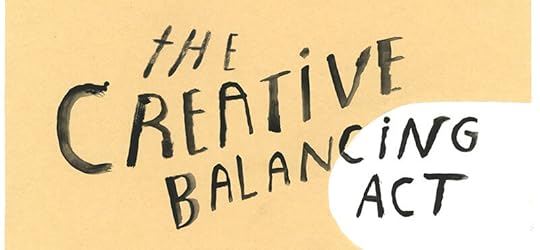
WELCOME WELCOME, step right up! Today we’re talking about balancing acts. Almost sounds like we’re going to the carnival. (Now I want funnel cakes!) Nope! But we are exploring a different kind of skillful balance trickery: being an illustrator!
While this post could seem somewhat sporadic, what I aim to communicate is the creative processes we experience as commercial artists. I’m breaking today’s posts down into four acts:
Juggling, Cycling, Blocks, & Balancing.
Ready? Get your french fries and vinegar! Funnel cakes! Popcorn! Into the tent we go!

ACT 1: JUGGLING
Art for money. Art for others. Art for us.
It’s all about keeping a balance of the three. In my illustration program, we never discussed balancing these factors but it was more like on the job training. As we navigate freelance illustration, we find a way to intuitively handle all the moving parts of the job. Every artist is different of course depending on their industry or goals.
Art for money.
We make art to make a living. Finding clients is obviously important, but finding the right clients is even better. In the beginning, it makes sense to say yes to every offer. Then, we learn to be discerning and say ‘no’. Too little client work is nerve wracking - besides the factor of income, it’s beneficial to collaborate and also have external pressure. Too much client work though, can diminish our time to play and experiment, thus producing a whole portfolio of work we don’t even recognize, or worse, like!
Art for others.
We make work to share. It’s rewarding when that work is well received by the industry or those around us. The flip side of that, is that whether we are influenced by strangers we admire, or those we’re close to, it can be confusing to parse out what we actually want to make vs what we think we should make. Sometimes this is direct: “Oh you’d be good at xyz, you should do that.” Or, a client may come to you with a moodboard of other artist’s work and the perimeters look slim. Other times, it’s more subconscious, “If I make a picture book, it should look the way others have done it.”
Art for us.
We make art because we’re artists. Why did we become illustrators? We might have loved the act of play, invention, problem solving, curiosity, patterns, story, etc. Sometimes the work we make for ourselves IS for other people. We may be propelled to create work for others in regards to environmental or racial justice issues. When I say art for ourselves, I mean the art that moves you - work you’d do if you never got paid a dime. If we don’t make personal work though, that impulse can be diminished and though it’s not gone forever, it can feel like a serious loss. On the other hand, if we make work we are truly impassioned with but can’t seem to earn an income from it, it can obviously cause major stress.
It’s no wonder the equilibrium is easily thrown off. Now, toss in more factors. Throw in running a business. Throw in taxes and contracts and promotion and marketing and making a website. Finally, throw in that pencil tip that keeps breaking every time you sharpen it! It’s maddening!
WOW this carnival got dark! You’re a terrible ringmaster Rebecca! I don’t share any of this to add worry, but more to affirm that if you ever feel stuck, frustrated, left out, uninspired, forgotten, confused, or angry in the process of illustrating, you are not alone. I cannot stress that enough. Juggling all of this is a lot, but it is doable. And it is such a rewarding profession.
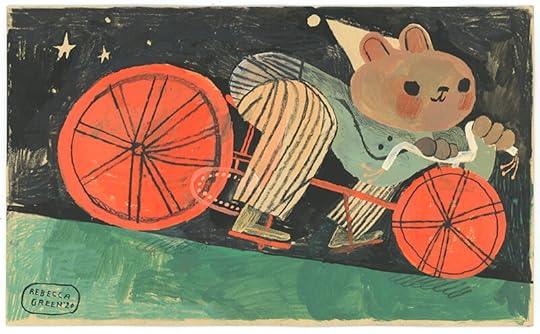
ACT 2: cycling
The Creative cycle
The first time I learned about the creative process being cyclical, it was from a wise old professor. He asked about my plans after graduation and I told him I didn’t even want to think about art for a while. I felt guilty about it until he explained that creativity was a cycle like everything else in life. It made me feel a sense of stability like I could manage creativity - it wasn’t an elusive beast. Further in my career, I started to recognize my own patterns of working. The changing phases grew more familiar, almost comforting. It became easier to diminish the lamenting, let go of the struggle and as my friend Joe Kolean says, let it ride. It also reinforced that momentum begins by going back to the drawing board, not avoiding it. After some much needed inspiration of course.
While the creative cycle looks similar for most, it changes depending on the person.
My creative cycle looks something like this:
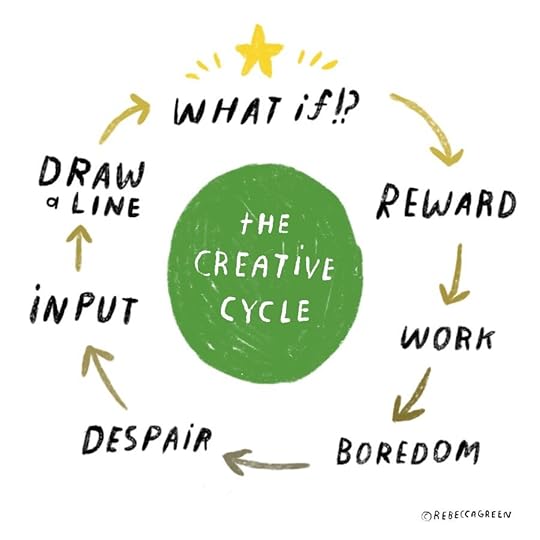
The best part is the WHAT IF. This is the aha! moment. The spark, the flow, the tingle. I then share my new creation - it gets a reaction, a REWARD. “They like me, they really like me!” This is fun, I’m glad I finally figured this whole illustration thing out. Someone then hires me. “Why yes, I will do this for WORK.” Oh no..now it’s actually feeling like work. I’m not really challenged any longer, but it seems to be doing the trick. Ugh this is no longer fun, why did I say yes to that project? I can’t handle the BOREDOM. I never want to make this again. Now I don’t know what to do. I enter the depths of motivationless DESPAIR. I’m worthless. I need to pay my bills. I’ll look up job boards. What am I doing?! I cry and lament to friends. Oh yeah, I probably just need INPUT. I go to a bookstore or somewhere new. Oooh I like that. That could be fun to draw. I drag myself back to my desk again to DRAW A LINE. At first it’s garbage so I draw another. Maybe another. OH this looks like something…yess….omg WHAT IF?!
When I first experienced the highs and lows, they seemed chaotic and permanent. A tingling AHA! moment was too wild to harness or trust. Conversely, a loss of motivation felt like the bitter end. During the lows or lulls, I sulked a lot. I napped and cried, felt lost, felt washed up. While those phases still happen, I now know how to approach them. Now, I am accepting and proactive (mostly!) Instead of lamenting for days on end, I understand it is part of the process. Lulls no longer mean utter defeat. They signal a need for rest and input. To refill my well, I ask myself, “What am I curious about? What would be fun?” Often the answers are things like cooking, hiking, thifting, dancing, or visiting a bookstore. Once I’ve had some time out of my own head, I’m more likely to have a spark of inspiration that sends me back to the drawing board, thus propelling me towards the ever sacred tingle. (Should I stop calling it that?!) I’m now learning to trust that tingle.
Curious about your own creative cycle? Try to identify patterns. Pay attention to how you’re approaching your work or creativity. Are you full and inspired? Are you depleted and low? Once we know more about ourselves as artists, it becomes easier to *almost* enjoy the rollercoaster that is the creative cycle.
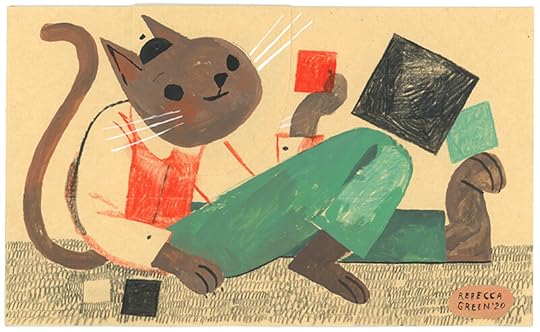
ACT 3: BLOCKS
Creative Blocks vs. Creative Burnouts
I’ve heard the terms creative block and creative burnout interchanged. Having experienced both, I feel they are quite different. Let’s explore some possible causes and hopeful solutions so you can figure out the problem, pick yourself back up and get to creating again. Also obviously I’m not a creative philosopher, therapist, or specialist, but just one artist sharing her experience.
CREATIVE BLOCK
Are creative blocks real? I’ve heard arguments on both sides. It’s true, relative to the harshness of life, how can anyone lament painting? On the other hand, I’ve felt the deep woes of creative frustration. Here’s where I stand: creative blocks arise, but instead of focusing on whether or not it’s actually an obstacle, it’s best to focus on the solution. Do not let it be an excuse for a continual refusal to show up.
Causes of a creative block:
Fear
Making art is vulnerable and scary! We can be deeply afraid we’ll come up empty handed, revealing how lacking we think we are. Much safer to avoid it, thinking, “I could make that…but not right now.”
Boredom
We need a balance of challenge and mastery. If work becomes predictable and comfortable, it’s no longer fun. We run on autopilot which is never enticing.
Intimidation
A little different than fear in that it’s more technical. Maybe we don’t have the technical skill so we avoid the process, even though practice leads to skill. It’s also intimidating if our options are limitless.
Shoulds
I have the word should on my studio wall with a big red X through it. We can feel debilitated by the result before we even start the process. Either we’re already bored by it, or it’s too elusive.
Solutions for a creative block:
Begin
We think it has to be more complicated but often it isn’t. Want a place to begin? Draw your kitchen. Draw your dog. Throw a blob of paint on a piece of paper and see what it looks like. Momentum is built, it doesn’t appear out of nowhere.
Circumnavigate
Blank paper is scary. What about that gross scrap paper on the floor? Make something on that. I often make my best work on scraps as the final paper is too precious. Also, you can dodge your inner critic by assuring them that the thing you’re about to making doesn’t count.
Limitation
Limit yourself to two tools. Two colors. Maybe a specific size. Put a bunch of words in a jar and pick one. Draw that and no cheating. We need boundaries to spark problem solving.
What If?
Replace should with what if. Instead of asking '“What should I make?” Instead, try saying: “What if I made….” More ideas arise when the question is posed as a possibility.
CREATIVE BURNOUT
Back in 2018, I shared a long blog post on creative burnout. In it, I wrote, “If a creative block is a rainstorm, a burnout is a hurricane (and you're out at sea, alone.)” I had never had something quite as dramatic prior to, nor since, and I hope I never do again. A creative block is more of an aversion to starting, but a creative burnout comes from the inability to say no. It’s a result of ignoring your physical or mental boundaries in regards to producing.
Causes of creative burnout:
Overload
Saying yes to too many things, whether in life, work, or relationships. As freelancers, it’s easy to say yes to everything and be ‘on’ all the time.
Disregard
If you continually ignore signs that you’re physically or mentally stressed, you can simply break under the weight. Leading up to my creative burnout, I ignored warning signs. My upper back, chest, and neck became extremely tight. I couldn’t get a deep enough breath and I broke out in a rash on my neck. I wept at my drawing desk and I screamed on my way to work just to feel a release of tension.
Force
If you need to rest, fill up your tank, or gather input yet you force your way through producing again and again - eventually you can experience burnout.
Solutions for a creative burnout:
Rest
You may need a serious break. There’s nothing wrong with finding a different income source to ensure stability while freeing your mind from creative pressure. Sometimes, just a week or two can do wonders. I know stress is glamorized to a certain extent but know that ease and a steady workflow are much more likely to lead to a long and sustainable career.
Curiosity
Stay curious, take time to explore something completely different from your norm. This past year I took singing lessons and it was amazing what learning a new skill can do. Try to dig into other parts of yourself that maybe you’ve neglected because they seemed too indulgent.
Acceptance
The last thing you need is to add stress by feeling angry at yourself. Understand that it is temporary, no matter how painful it feels. From my own experience, bouncing back from a burnout isn’t a lightswitch moment. It could take months of showing up, seeking joy, allowing the ground to shift, and finding a new and more sustainable workflow.

Take care of yourself. Take care of your work.
The final act of our show! It always feel like a balancing act to keep up with life and work (and I don’t even have kids! How do you do it!?) I wanted to leave with you with a couple tips that have helped me stay motivated, focused, or inspired.
PERSONAL DAYS
I highly suggest choosing a day of the week (even just an afternoon) and dedicating it to personal work. This work is not for sharing - not right away anyway. Make something you’re too frightened to make. Play with a new material. Test out some techniques you’ve been wanting to try.
LEARN
Take a class. Find a free tutorial to start something new. Try your hand at a new art form even if you don’t plan on using it right away. Learning keeps our brains fresh and humble.
CARE FOR YOUR BODY
Go for a walk, dance, run, or do yoga (I love Yoga with Adriene, it’s free!) Eat some plants. Get enough sleep. We are nothing without our health. I’m not exactly a pinnacle of healthy living, but I’ve learned a lot in the last decade. I didn’t grow up taking care of my body. I never worked out, I survived on tater tots and hot pockets and I smoked til I was like 24. And it’s A-OK if that sounds like you and you’re happy. But taking care of my body has helped me mentally - and I need my mind for work!
SET A TIMER
Last year, I took Lisa Congdon’s Time Management class and it really changed the way I set up my work schedule. One of the biggest take-aways was setting a timer and putting away distractions so I could work in focused increments.
TAKE BREAKS
Taking little brain breaks between your focused work time is really healthy for your workflow. Don’t use it to check email - use it to take deep breaths or walk outside. Use it to eat chocolate or pet your dog. It’ll make powering through a long day much easier.
THAT my friends, is a wrap! if you made it this far, I applaud YOU! Thanks for reading, for showing up, for continuing to make the world better with your work. And remember - this is a wild year. Take care of your creative self!
Now go out (masked of course) and celebrate September! We’re about to make boat loads of apple crumble and bust into some scary movies soon. I love Autumn!
Until next time,
Becca
July 31, 2020
The Creative Compass
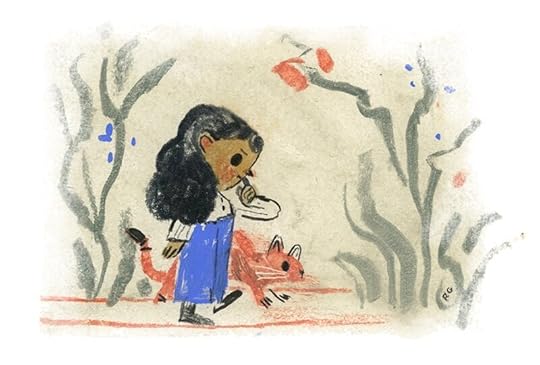

What do we do when our creative path becomes muddled? Maybe it has abruptly ended. Maybe it’s a little grown over. Maybe the fog of comparison has clouded our view of a path once clear. I’ve been illustrating for ten years and have pivoted often - from gallery work to editorial illustration to publishing. Having pivoted, I know the road is never straight and narrow. I know the importance of checking my own internal compass often.
When I graduated in 2010, I was enamored with the editorial illustrations of Susy Pilgrim Waters. I emailed her to ask advice about freelancing and to my great surprise, she responded. “Make the work you want to get hired for.” How simple. Yet it’s this advice I hear on repeat in my head - I use it as a prompt to dig deep - I use it as a prompt to make my compass!
It’s helpful especially between projects. We cry out for ‘more time to make the stuff we love’ and then as soon as we have the time, we find ourselves sulking, freaking out, incessantly checking our email to see if we’ve been forgotten forever. (just me?) If only someone could hire us for a job we partly enjoy so we don’t have to actually bust through the fear that there’s no good work on the other side of our ‘stuff we love’ notion. (Though I won’t discount the very real financial scare of having nothing in the pipeline AND don’t get me wrong I love my clients, but you know - a dream job is a rare occurrence.)
When I feel creatively lost or unexcited about my work, I think of those words: Make the work you want to get hired for. And then I make a list by asking myself these questions:
What would I create if I were a child again?
If I could hide in a cave and make whatever I wanted, what would I make? Better yet, what if I didn’t let my inner critic into the cave with me but I made her sit out in the rain?
What creative activity feels so indulgent and playful and risky that it could never possibly be a job and no one in their right mind would actually give me money for it?
I write down every hairbrained idea that comes to mind. Sometimes the projects are clearly potential jobs: An “illustrated manual for a campground” or “tiny illustrations for tea packets” or “an illustrated menu for a community kitchen.” More exciting - many answers aren’t ‘jobs’ at all: “build a puppet theatre complete with lights and a curtain” or “make a castle out of strips of cardboard.” Once I start writing, I instantly feel realigned. In my mind, I’m a kid ‘pretending’ to do these types of jobs, whereas my adult inner critic brain would be quick to limit my options due to ‘industry standards or gatekeepers or other artists already in the arena.’
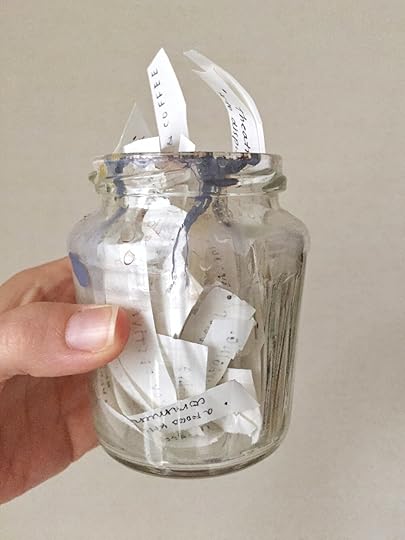
My Compass Jar
Recently, I was feeling lackluster about my work, so again, I turned to my compass. But this time, I made a compass jar, and you can make one too. I’m embarrassed at the simplicity of this, but NOT REALLY because I think we often overcomplicate creativity.
MAKE YOUR OWN COMPASS JARYOU’LL NEED:
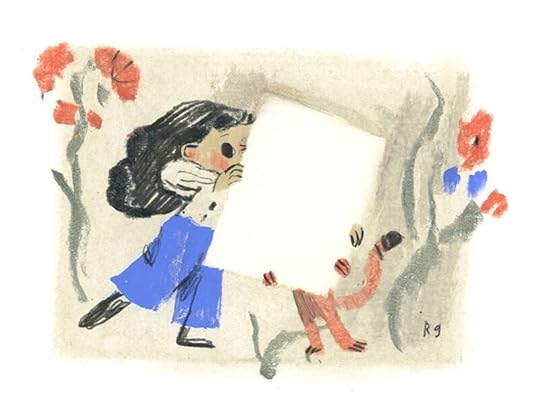
A SHEET OF PAPER
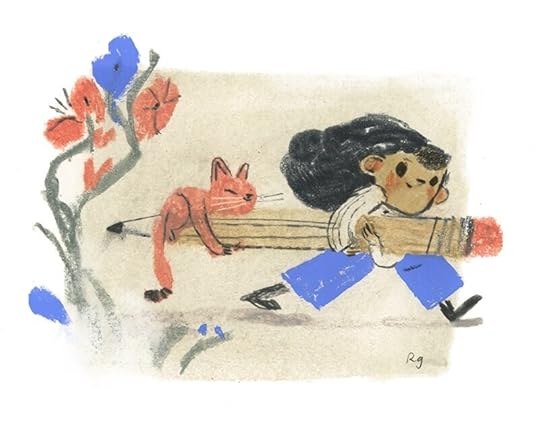
A WRITING INSTRUMENT
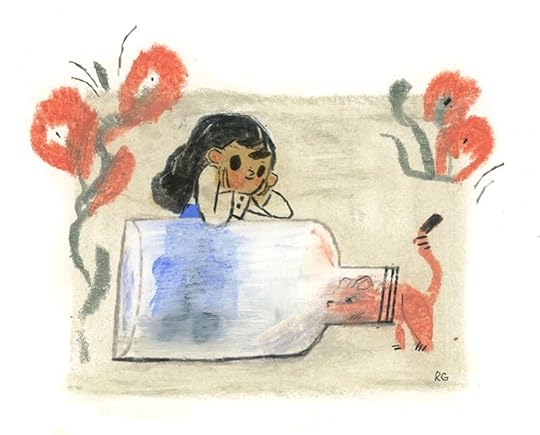
A JAR (OR TIN OR BOX OR WHATEVER!)
**You can use materials as part of the self discovery process. Write with your fanciest pen, try a special paper, find an old magical looking jar or something that fits your aesthetic.
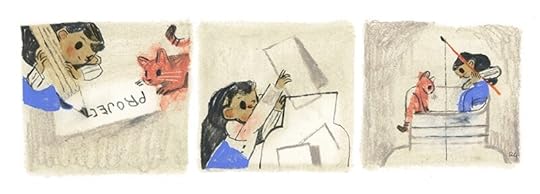
INSTRUCTIONS:
Write down 30 (YES THIRTY) dream jobs, activities, creations, or projects.
I stick to 2-3 words here (you’re not writing a paragraph, unless you’re into that, in which case be my guest!) You can use my questions from above: What would I create if I were a child again? If I could hide in a cave and make whatever I wanted, what would that feel like? Better yet, what if I didn’t let my inner critic into the cave with me but I made them sit out in the rain? What creative activity feels so indulgent and playful and risky that it could never possibly be a job and no one in their right mind would actually give me money for it?!
Fold em’ up (or not) and place them in the container.
Fish one out (no peeking!)
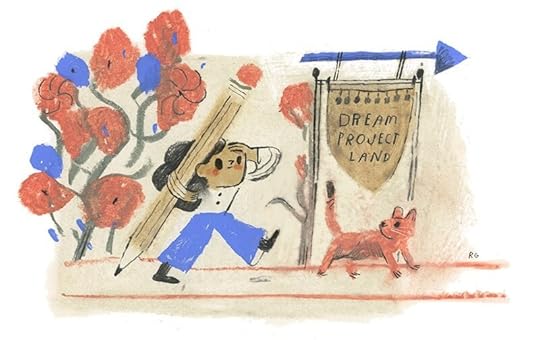
and VOILÀ!
Now that you’ve consulted your own inner compass, the path should feel a little more clear and your mind should be filled with dream projects to work towards.
This exercise, like I said, is simple. Wildly and laughably simple. And we all know there is so much that goes into building an illustration career. But I also believe in the simplicity of it all - I think deep down each of us has an idea, a true idea of what we love and what we want to build. It just takes the act of stopping for a moment to listen and trust our instinct.
If you do this and find it helpful, I encourage you to embark on the projects you wrote down. Fill your portfolio with jobs you actually want - not just the ones you’ve already been hired for. If your dream jobs lean more into design, packaging, etc, you can simply do mock ups of your projects to put in your portfolio. (I found a helpful blog post on doing mock-ups here). If you’re leaning more into editorial or publishing, there’s not much of a need to mock anything up. Did I make everything on my list? Sadly no. Or…not yet! But I’m working on it. I’m working towards creating more of my own content, my own projects, and it’s been useful to have my little compass jar at the ready for when I feel I’ve run out of ideas.
If you make your own jar, share it with me on IG! Tag #creativecompassjar so I can see all the bottles of dreams.
❤️
BECOMING A GOOD CREATUREGiveaway + Activity Kit

BECOMING A GOOD CREATURE by Sy Montgomery comes out September 29! (Which will be here before you know it - how is it already August?) To celebrate, the lovely folks at HMH are doing a pre-order giveaway campaign and it launched this week! Here are some details:
Pre-order your copy of BECOMING A GOOD CREATURE at any retailer, fill out this form, and email hmhkidsbooks@gmail.com your proof of purchase to be entered to win.
25 lucky winners will receive:
+ 1 hardcover copy of HOW TO BE A GOOD CREATURE, signed by Sy Montgomery
+ 1 limited edition Art Print from BECOMING A GOOD CREATURE
+ 1 book plate, personalized and signed by Sy Montgomery and myself
+ 1 sketch print from the interior artwork
Ends 9/28, US only. (If you pre-ordered the book before this week, you can absolutely still enter to win.)
Click here for more details.
They also put a ridiculously sweet activity kit together to go along with the book.
You can download it free HERE!
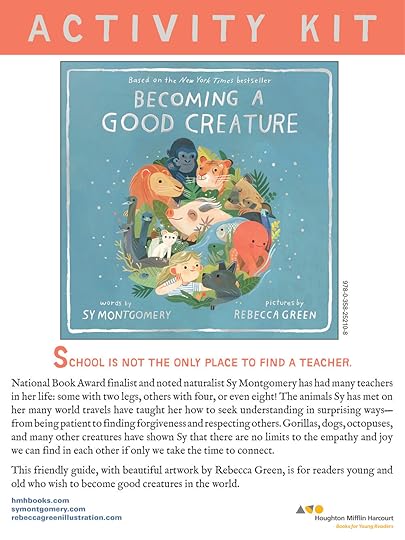
I think that’s it for now! I’ve got a couple of other cover reveals and announcements to share but it’ll give me a reason to come back and do another post soon. I’ll be honest, my days are running together and it’s tough to keep up the momentum - life is put on hold and it’s difficult to plan anything. My eyes are glued to the news. Some is promising, some is terrifying. But carry on, we must. Make art, we must. Most importantly VOTE we must. Sending all my most creative thoughts your way until next time.
xo,
Becca
June 8, 2020
Thoughts + Drawing From Life

Before we talk about drawing from life, let’s talk about something more important. These past two weeks, the Black Lives Matter movement extended across the US and the globe, a movement that should have been widely acknowledged and heeded long ago. A call that should have been answered long ago. I am so sorry to the friends and families of George Floyd, Ahmaud Arbery, Breonna Taylor, and countless others as they grieve the loss of their loved ones.
I won’t pretend to have long-standing or thorough insight because I’d long assumed being not-racist was enough. But these last two weeks have opened my eyes as to why we must do the work to become antiracist. As a white person, I acknowledge that I have immense privilege. The systematic racism built into the core of the country must be dismantled, and it means many of us have to get uncomfortable and we have to do the work. I’m committed, for the long haul, to listen, learn, and unlearn. Even as I’ll make mistakes, I promise to work, as an individual and as an artist, to dismantle white supremacy and lift up marginalized voices. To lift up Black voices. I stand with you.
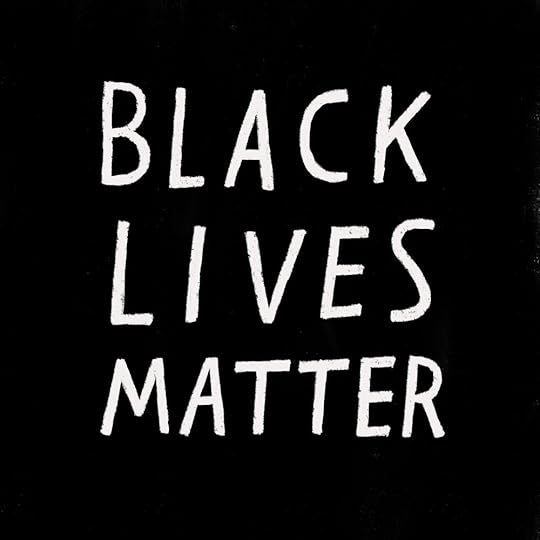
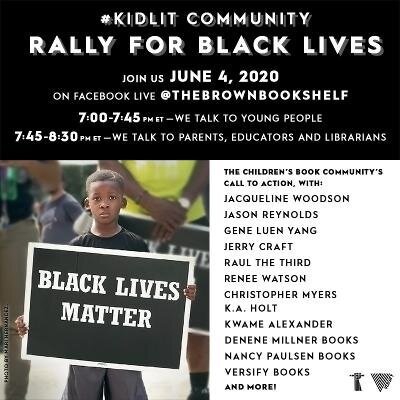
Photo from The Brown Bookshelf
This week, The Brown Bookshelf hosted the KidLit Rally 4 Black Lives. “Around the nation, people are hurting. Award-winning authors Kwame Alexander, Jacqueline Woodson and Jason Reynolds (have) organized a Kidlit Rally for Black Lives.” The rally was incredibly insightful and amazing - the first hour was geared towards children, and the second hour was for librarians, teachers, and adults. You can find the video on The Brown Bookshelf youtube channel. You can also find their list of antiracist resources for children, families, and educators here.
This week, I also began reading How To Be An Antiracist by Ibram X. Kendi and I highly recommend it.
I’ll be sharing more as I read them, though there are countless lists available if you need a place to start.
ALSO VOTE.
I’m in the process of planning and organizing ways I can be of service not just this week, but in the long term. Beyond voting, donating and learning, I am focusing on ways to be of service in the realm of promotion within the publishing/illustraton industry, and mentoring.
Black Lives Matter.

Drawing from Life (again) May 29, 2020
Maybe you’re a pro at drawing from life. Perhaps you find time to paint on location, sketch a study of your kitchen counter, or keep your hand drawing while stealing glances of the lovely folks seated near you in coffee shop. If so - I commend you! I, myself, had taken a hiatus from observational drawing. I came to think of it as boring, and since I wanted to move away from realistic work, I decided it just held me back from diving into more imaginary worlds. Really, the only time I drew from life was when I was alone at an airport, or if I was doing research for a project. I do love to journal but honestly, most of my visual journaling is done from memory and not on location.
During the last couple of months, however, staying (and working from) home, I dove back into drawing from life.
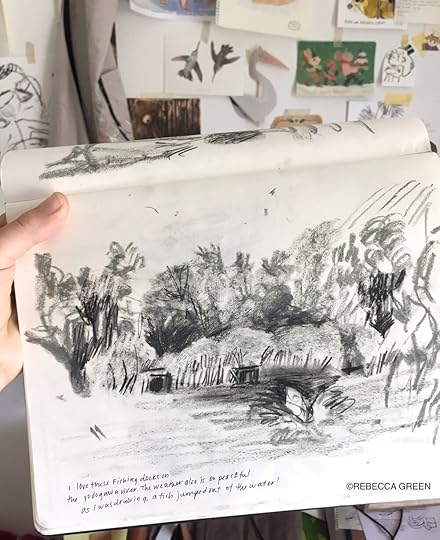
It all started with The Good Ship Illustration. I’m taking their six-week course (more on that later) which I love. It’s made me feel like…an artist! I learned about The Good Ship Illo from Helen Stephens’ newsletter (one of the three that run the course along with Tania Willis and Katie Chappell). I first learned of Helen’s work from Sana AlFalasi (@thecuriousnomad) when we met in Japan last year. We were discussing being loose and playful in our work and she mentioned ‘drawing in the rain’ - a tenet she’d learned from Helen. Fast forward a year later, and The Good Ship Illo released a free Sketchbooker’s Friend, which I used to ease my way back into drawing from life as a practice. What’s beneficial about this approach is that you don’t have time to think - you’re just reacting - allowing your natural tendencies to shine. For me, this is brilliant because I often overthink, placing more value on time and struggle than I do the joyous liveliness of a drawing unpolished.


Riding the observational train, I joined a virtual life drawing event in the UK hosted by Endless Love Creative. As I’m in Japan, it meant joining a zoom event at 3 am but it was completely worth it. What I loved most was the host, Charlotte, encouraged different drawing strategies to loosen up, instead of trying to realistically capture the image. Draw with your opposite hand. Concentrate on values. Do lines and high contrast. It was freeing. Also drawing in the middle of the night when the world is quiet was magical. The next day was not though, I was so tired!
View fullsize

View fullsize
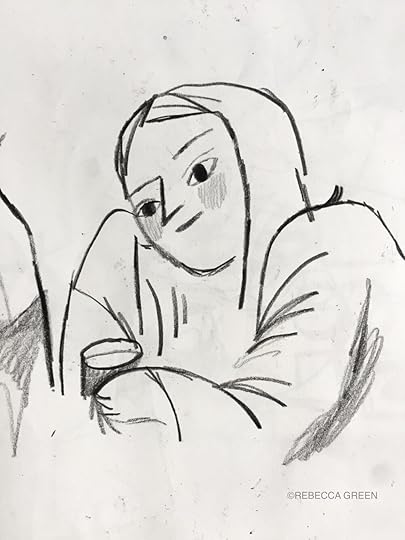
View fullsize

View fullsize

A couple weeks later, I joined the virtual sketch night at the Society of Illustrators. This one was two hours long, tons of 2 min. poses, some 5, 10, and a couple 15 minute poses. The models, The Pearling Principle, were amazing. They did an outfit change, so many fun and intimate poses, and there were many different props. The live music was performed by David Farer. This one was a little more traditional, but wonderful all the same. Seeing the emotion of the models too, was lovely. I’m really drawn to emotion and interaction in my work and doing studies like these reminds me of that.

View fullsize

View fullsize

View fullsize

View fullsize

I also dove into more observational drawing as part of The Good Ship Illustration course I’m taking. I’m doing the course rather privately and am not really sharing the process because I want it to be as free from pressure as possible. But I will share this study I did, because it demonstrates what I find to be the most valuable part of drawing from life: discovering personal patterns and making the imagery work for you.
For example, even though drawing foliage and plants is my least favorite thing to draw, I stood in front of a large chaotic bush bramble of who knows what and decided to pick out what I liked. I appreciated the competing textures, the lines of the tall grasses leaning in the wind, the tiny dots of ground covering. Then I noticed the tree branches thinly whirling up in the wind and it felt special to note it. Then, a bird landed on the branch and I knew I had to draw it because I like my images to have life in them. Plants are alive I know but YOU KNOW what I mean. I stood for maybe 5-10 min and inked in the lines with a thin felt tipped pen. The next day, I worked from the drawing and painted the scene in gouache. After, I painted just the tree, and then did some line work, which is probably my favorite from the whole lot of them.
View fullsize

View fullsize

View fullsize

View fullsize

What am I learning? That I love lines, simplicity, seemingly insignificant details, and emotion/interaction. I like for things to feel hand done, messy, human. When I draw from life, I hone in on what compels me and motivates me as an artist (which is a worthwhile discovery when you make images for a living).
It’s encouraging and reassuring for us to witness tendencies in our own practice - not to cement them - but to notice and celebrate them. It’s a way of finding ease, fighting insecurity, of growing at our own pace. If we feel what moves us, what motivates us, what feels so indulgent that we doubt it’s merit, we’re onto something. Those impulses don’t lie. And what’s better is that they don’t require outside validation. Instead, they are like small beacons welcoming us home. (AND I literally just realized why The Good Ship Illo’s logo is a lighthouse - clever!!!) It’s true!
SO drawing from life might not be your go to art practice. You might resist as I did. But I would bet a pan of brownies (worth more than gold to me) that if you sat down for five or ten minutes and drew what was in front of you, you’d learn not only something about drawing, but something about yourself as well.
Light Grey Art Lab Senior Show, May 22, 2020 - June 30, 2020

CONGRATULATIONS to the CLASS OF 2020.
LIGHT GREY ART LAB is currently hosting a virtual exhibition to showcase recent creative grads.
”The exhibition is a giant virtual gallery of the world’s collective commencement exhibitions for Spring 2020. This project is designed to give the students a chance to install/curate their work, similar to a commencement exhibition and envision their collection on display. Graduates will then have their work virtually exhibited alongside their peers from schools around the globe in an effort to provide the visibility and connection they deserve at a time like this. The virtual exhibition will launch May 22nd, 2020 and will be promoted through the month of June.”
As part of the exhibition, businesses, art directors, and professionals sponsored scholarships, mentorships, in kind donations, and such. I would like to share the three scholarship recipients whom I had the honor to award!
MELGADINE MENTORSHIP: Sònia Albert
Her exhibition consisted of three projects:
”The first project is a sequence of a boy playing with his own shadow. Reaching the point were the imagination wins the reality. The artwork is done with mono-print with bits of drypoint.
The second project is a graphic novel, MIA, aimed to teenagers. It tells the story of how her first relationship becomes toxic, and how she evolves during this experience.
The artwork is done with ink wash and slightly colored digitally - to help explaining the mood of the moment.
The third project is another graphic novel, The Summer Camp, that tells the first time Greta goes to a summer camp and how she ends involved in a mystery story and tries to resolve it.
The artwork is done with pencil, black pastel and digital color, with a limited palette - to help creating the atmosphere and giving importance to the light.”
The requirement for this mentorship was that the work be some form of traditional media. When I saw Sònia’s work, I was captivated (and intimidated!) All of the work carries a level of confidence and expertise. The emotion that is conveyed through the most subtle marks is a testament to skill and care. Though the work is quiet, it absolutely pulls you in. It’s quite moving. CONGRATS Sònia! Below are images from the three projects, and you can find more of her work HERE.

© Sònia Albert

© Sònia Albert

© Sònia Albert
CHILDREN’S BOOK REVIEW: Julied Jasmin
Her exhibition is titled Eko in the Forest.
“The goal of my final year was to develop a narrative and a character for a children’s book that reflected a part of my heritage. Representation isn’t something that I got to experience growing up in England. So, I wanted to create a basis for a fun and heartfelt story that is rooted in my culture! Something that is playful and adventurous that all kids could get lost in- and perhaps providing some kids a chance to see themselves in a story where they may not otherwise.
Eko in the Forest is a story about a mischievous and hot-tempered young girl named Eko. After a confrontation, Eko is consumed by a darkness and finds herself lost in a forest full of ancient spirits and creatures she’s only ever heard of in bedtime stories. She discovers that there the forest is slowly turning to stone and dying. To be able to return home she must journey to heart of the forest and return the fire that once allowed it to thrive. Healing must take place before the forest is restored and she can return home.”
What I love about Julied’s work is the brilliant balance in character and setting. The setting is a chracter in and of itself and there is a lush and detailed balance between the two. The emotion, movement, and strength of Eko shines. I can’t wait to see this published - CONGRATS Julied! Below are some images from the project, and you can find more of her work HERE.

© Julied Jasmin
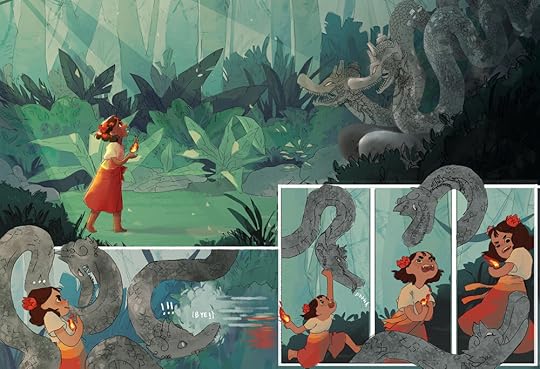
© Julied Jasmin

© Julied Jasmin
SUNDROP SCHOLARSHIP: Angie Hewitt
Her exhibition is titled, The Town That Never Was.
”A series of illustrations that follow Lucia on her journey through a ghost town to find her missing dog, Pillow.”
I immediately was drawn to Angie’s work for her use of line, lighting, and environment. The emotions are subtle but slightly haunting and moving which I love. She also is able to bring so much texture and detail a piece without it ever feeling crowded or unclear.
CONGRATS Angie!! Below are some images from the exhibition - learn more about her work HERE.

© Angie Hewitt

© Angie Hewitt

© Angie Hewitt
I want to extend a HUGE congratulations to every artist in the 2020 Senior Show. It was HARD to choose - I had dozens of names on my list and it was such a difficult task to narrow it down to three. I saw such brilliant work and I have no doubt we have some serious talent breaking into the industry. Congrats all - my hats off to you!
The Senior Show Exhibition is on display through the month of June. You’ll find artists graduating in Illustration, Design, Animation + Visual Development, Comics + Sequential + Kidlit, Studio Art and more. HUGE thank you also to Jenny and Lindsay and the crew at Light Grey Art Lab who work so hard to provide platforms and oportunities for artists.
Thank YOU, for being here, in this community. For the support for my work, for one another, for learning, and for being the kind and bright creatives you are.
All my best, always,
Becca
Rebecca Green's Blog
- Rebecca Green's profile
- 79 followers



